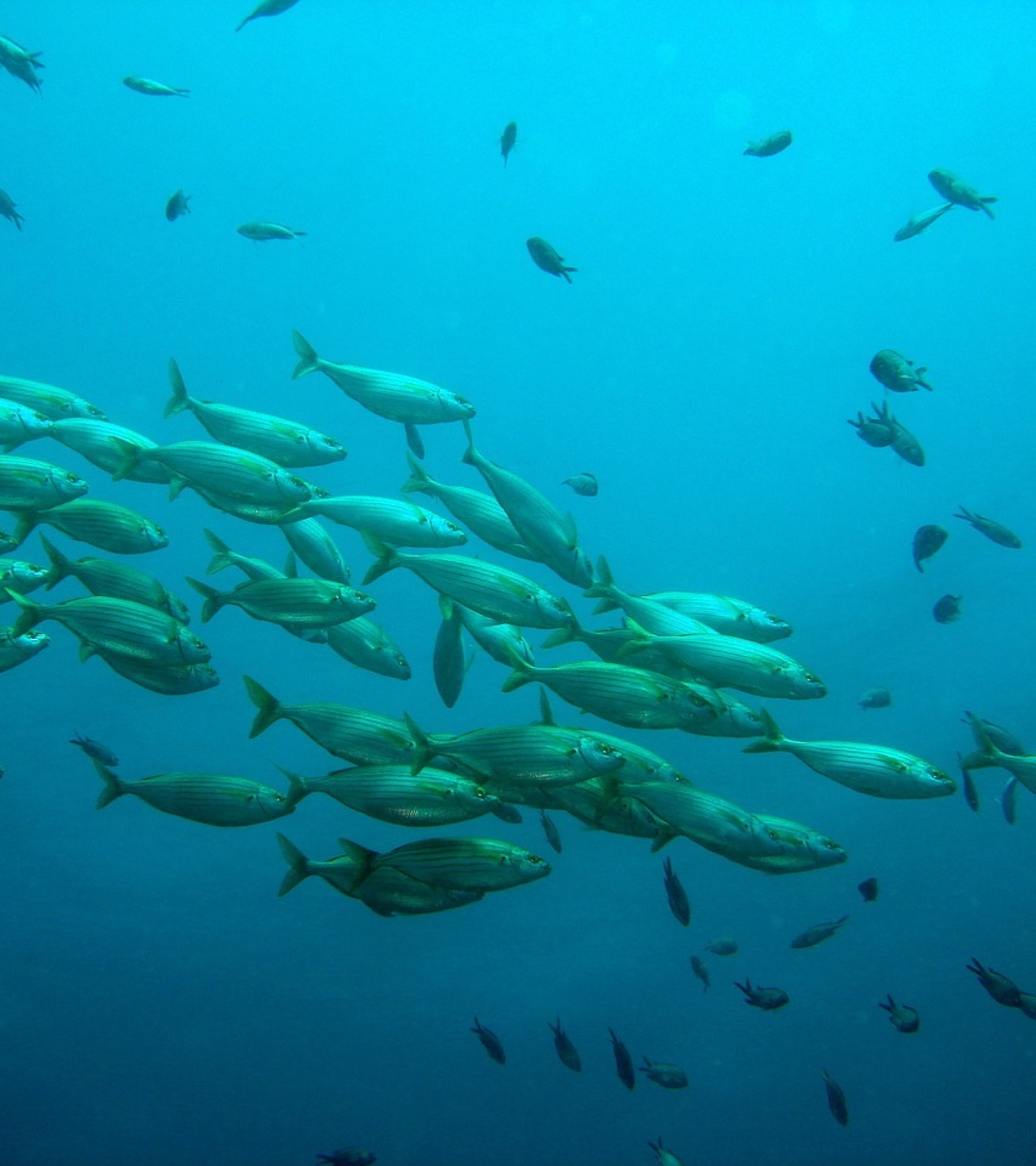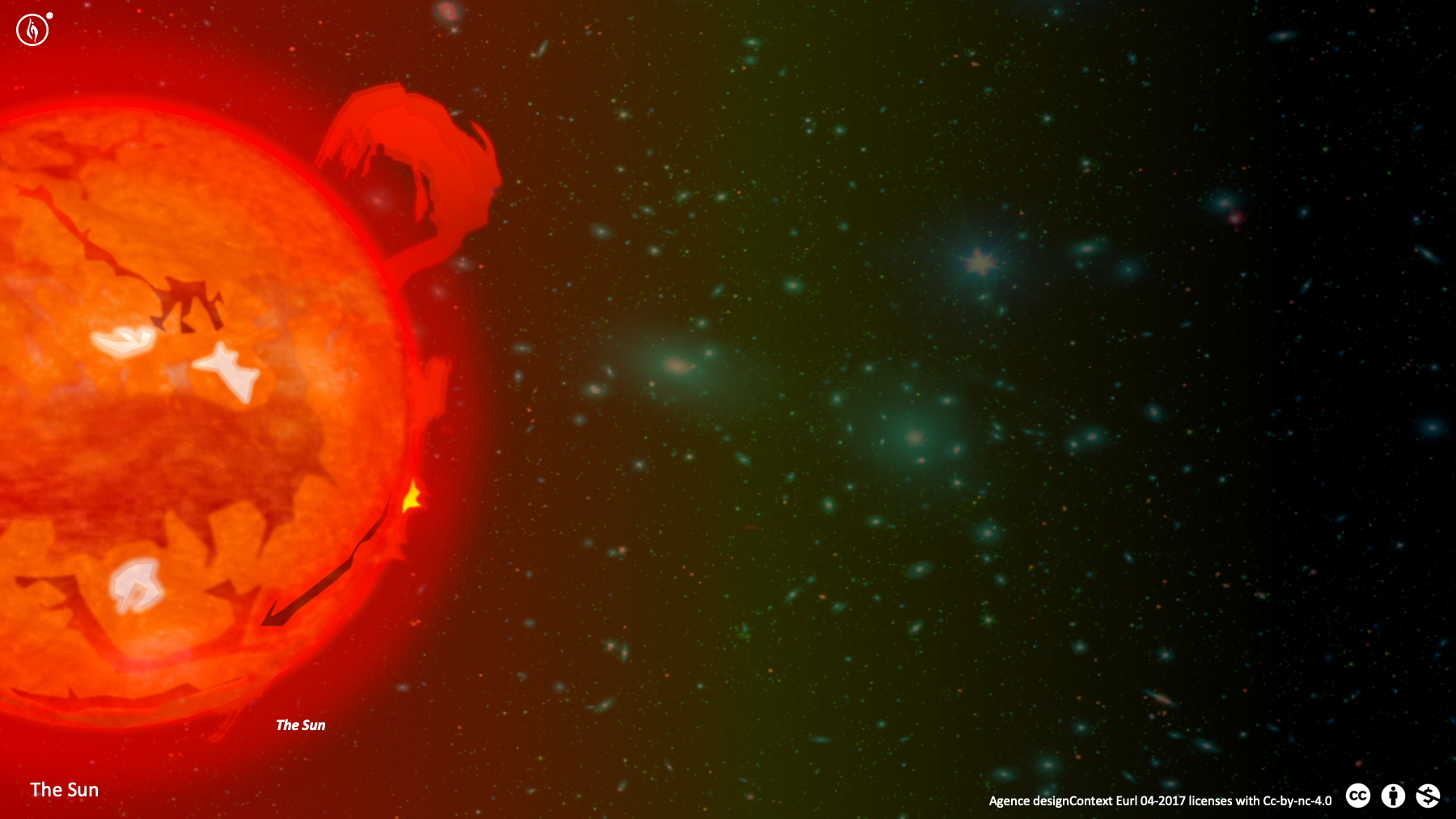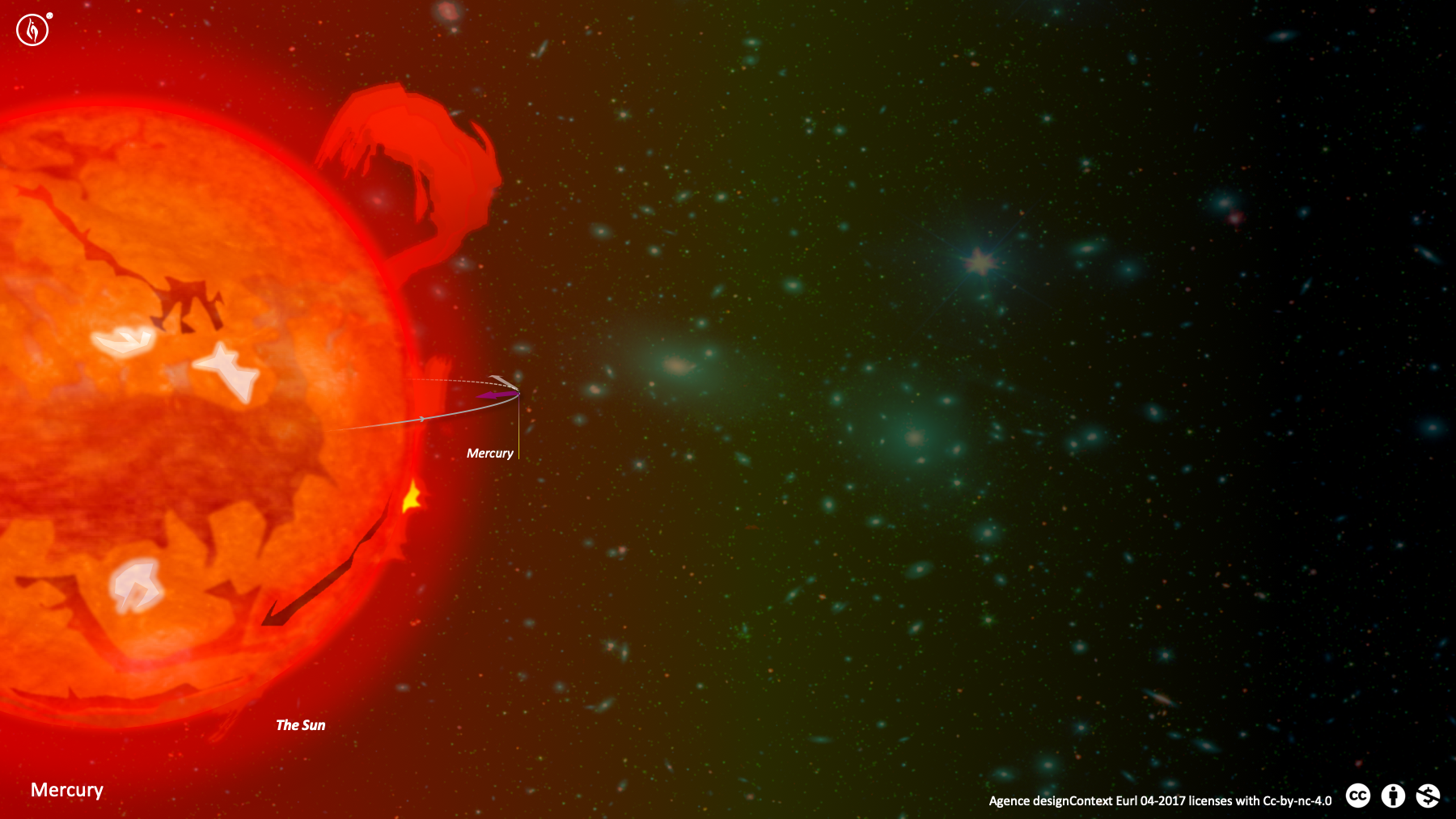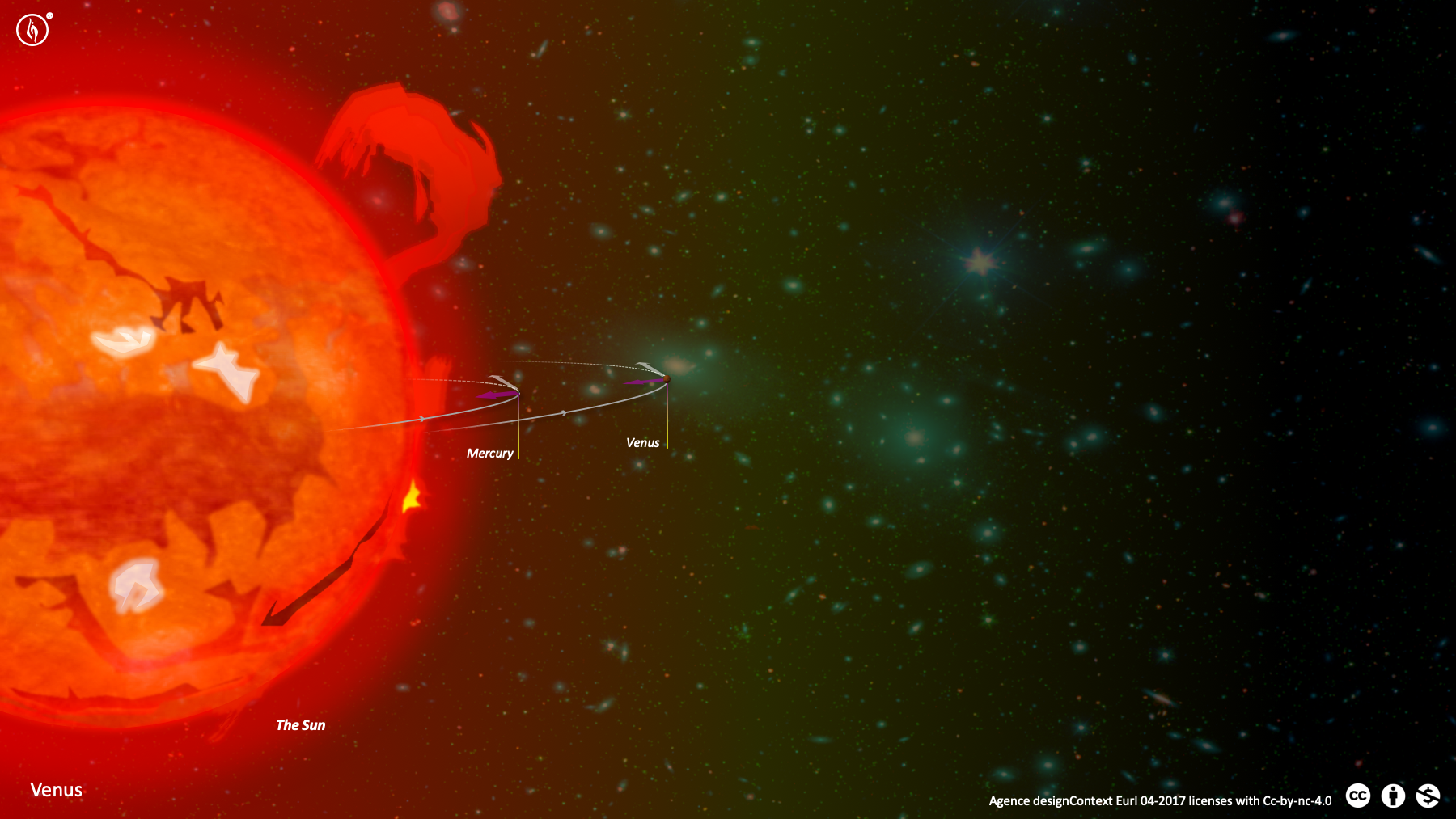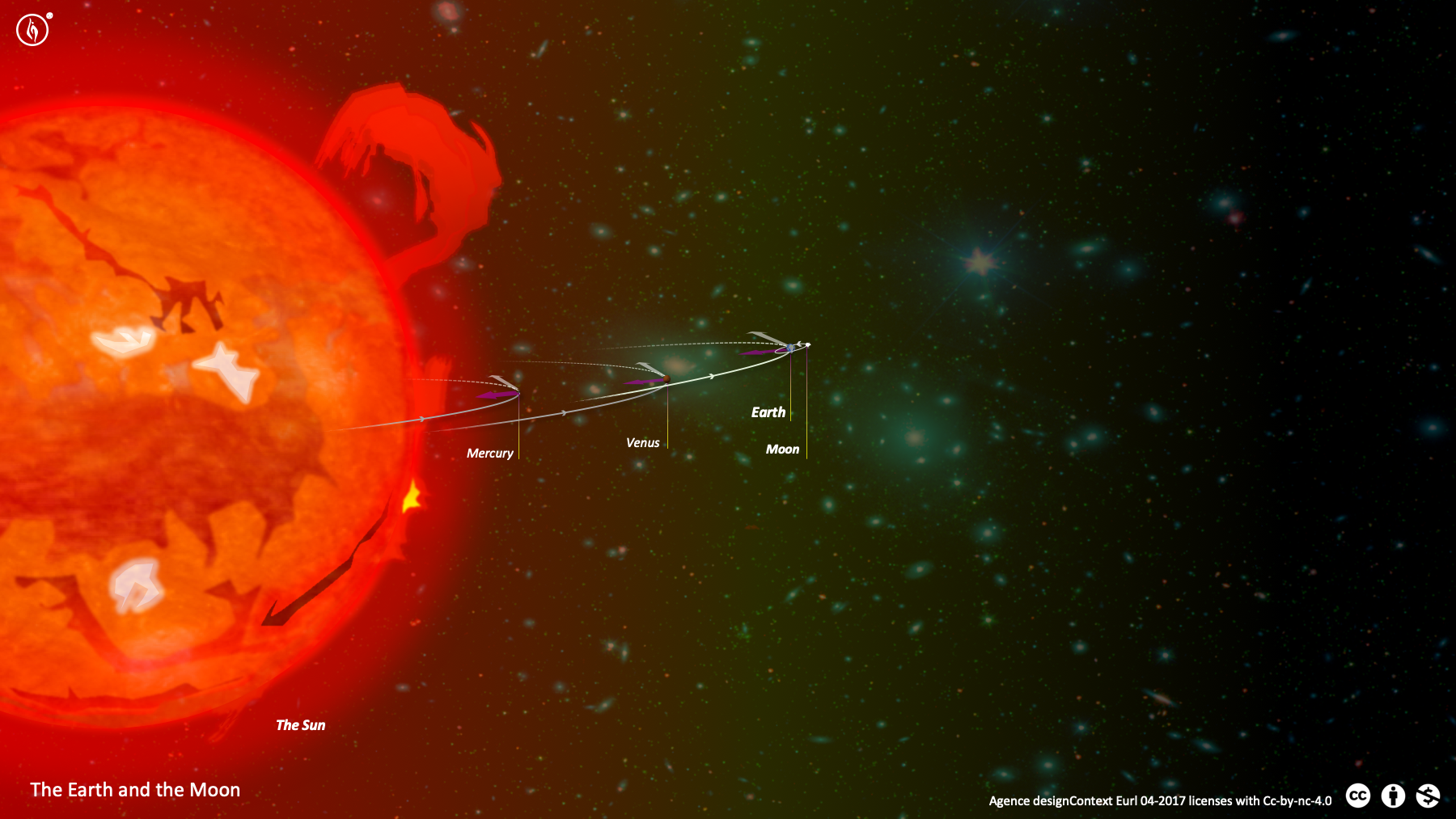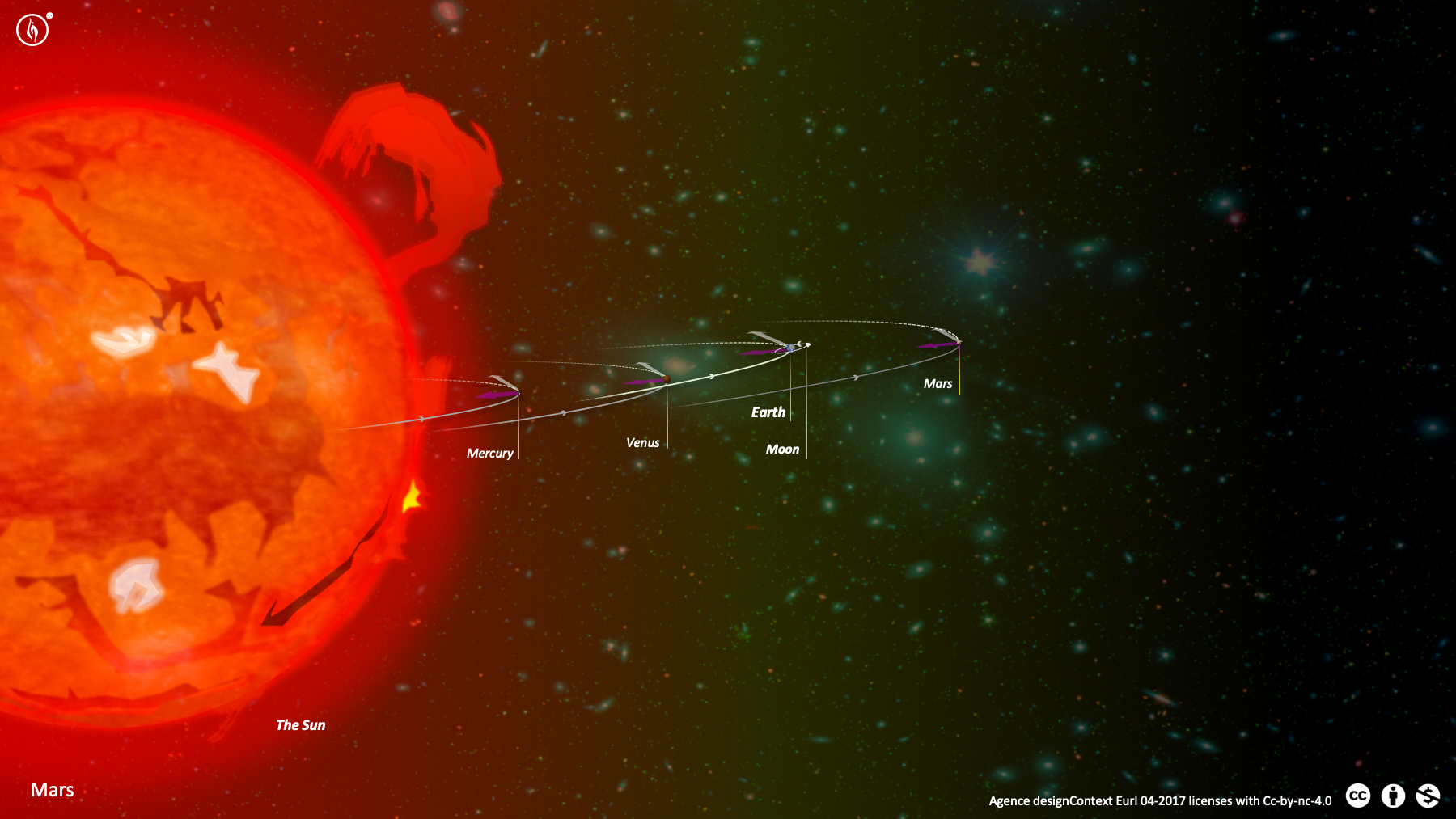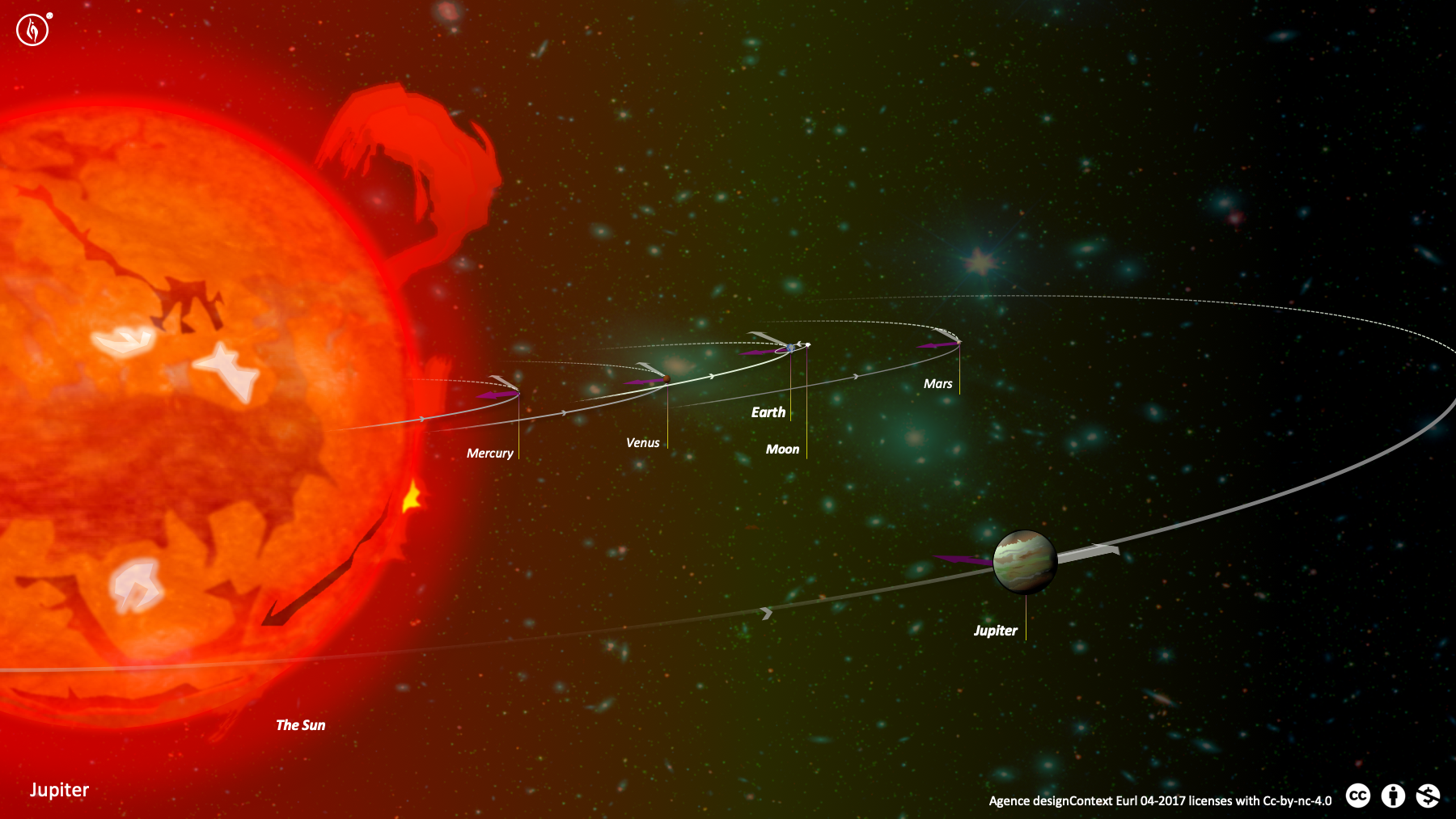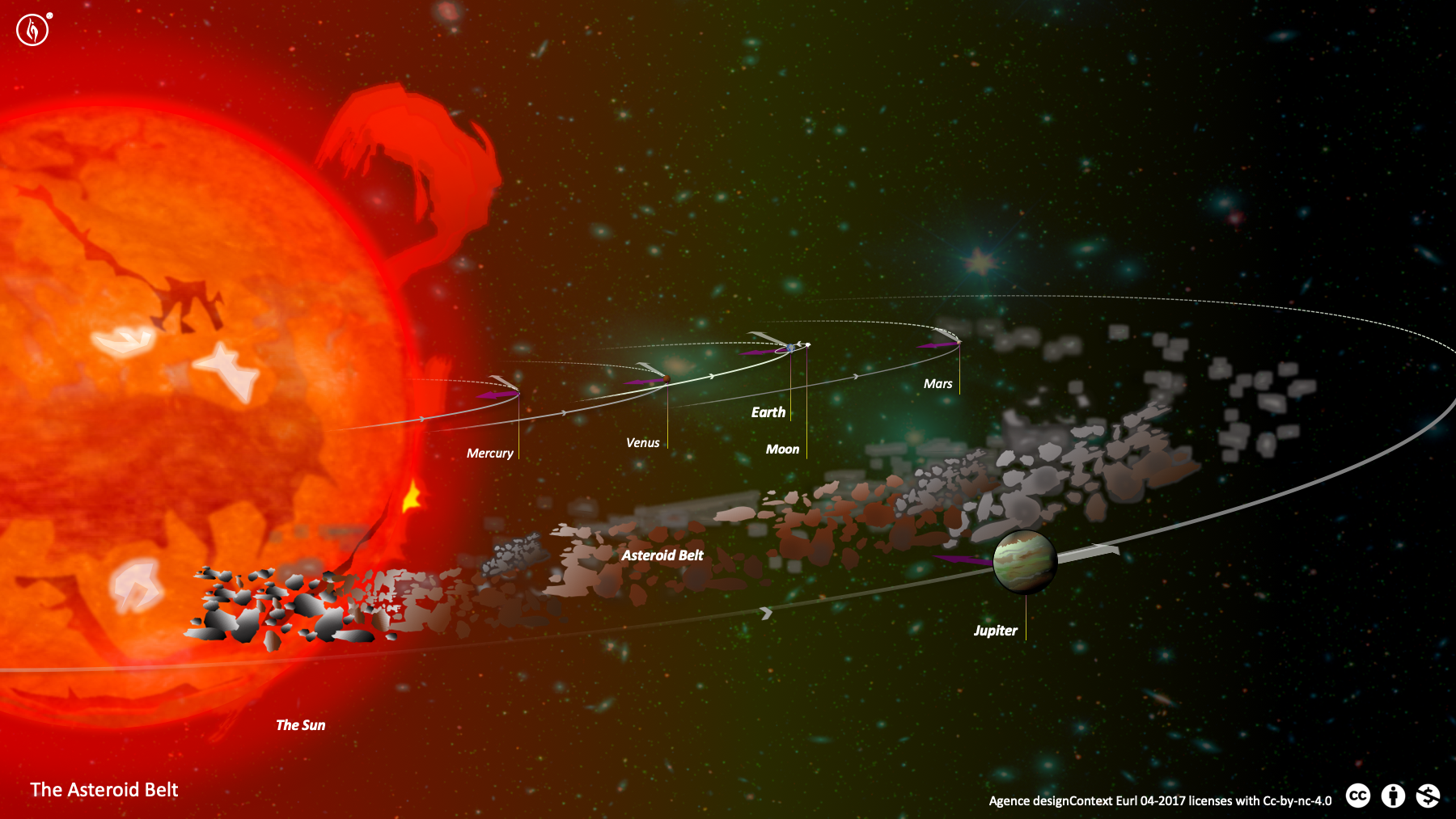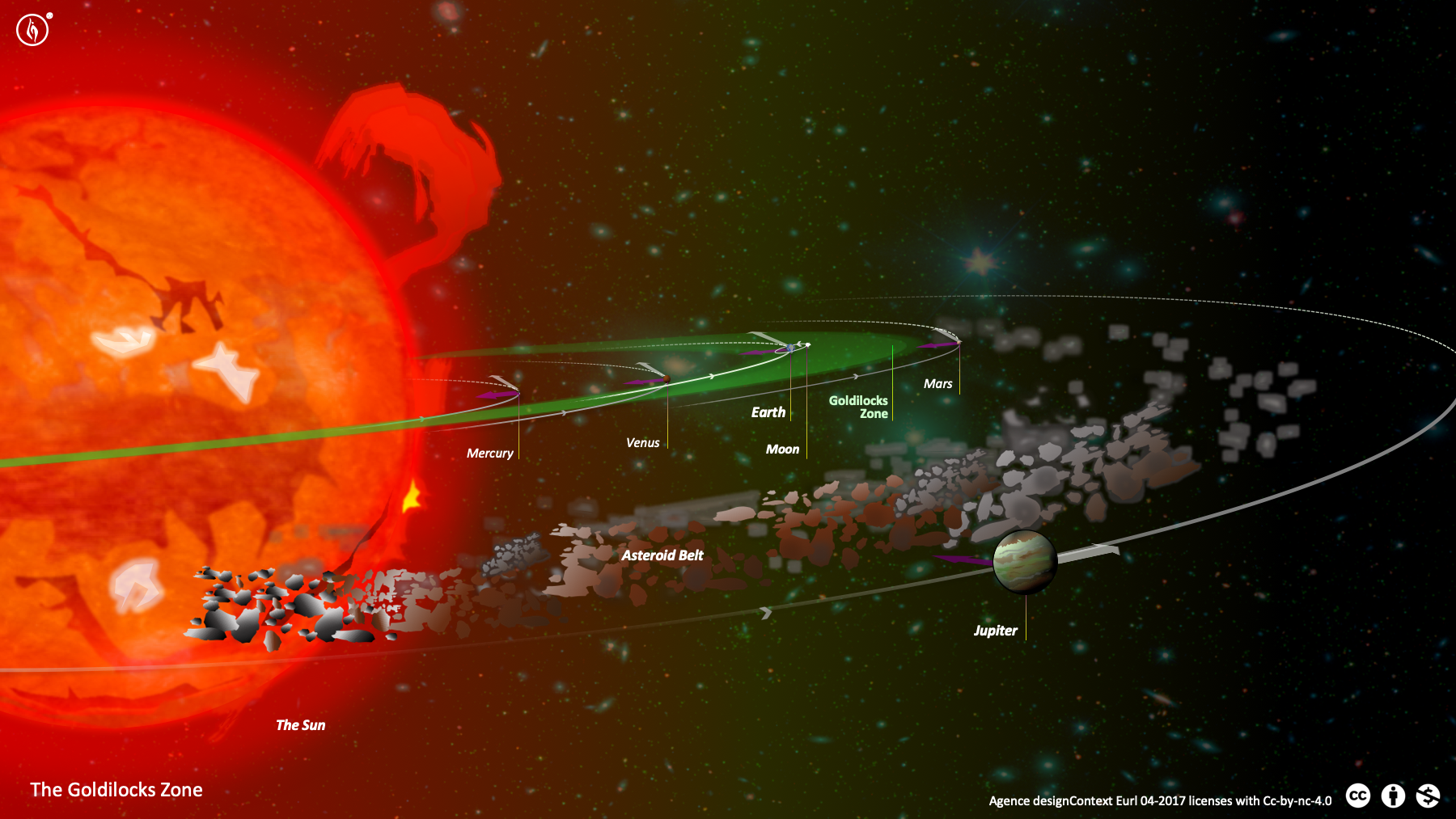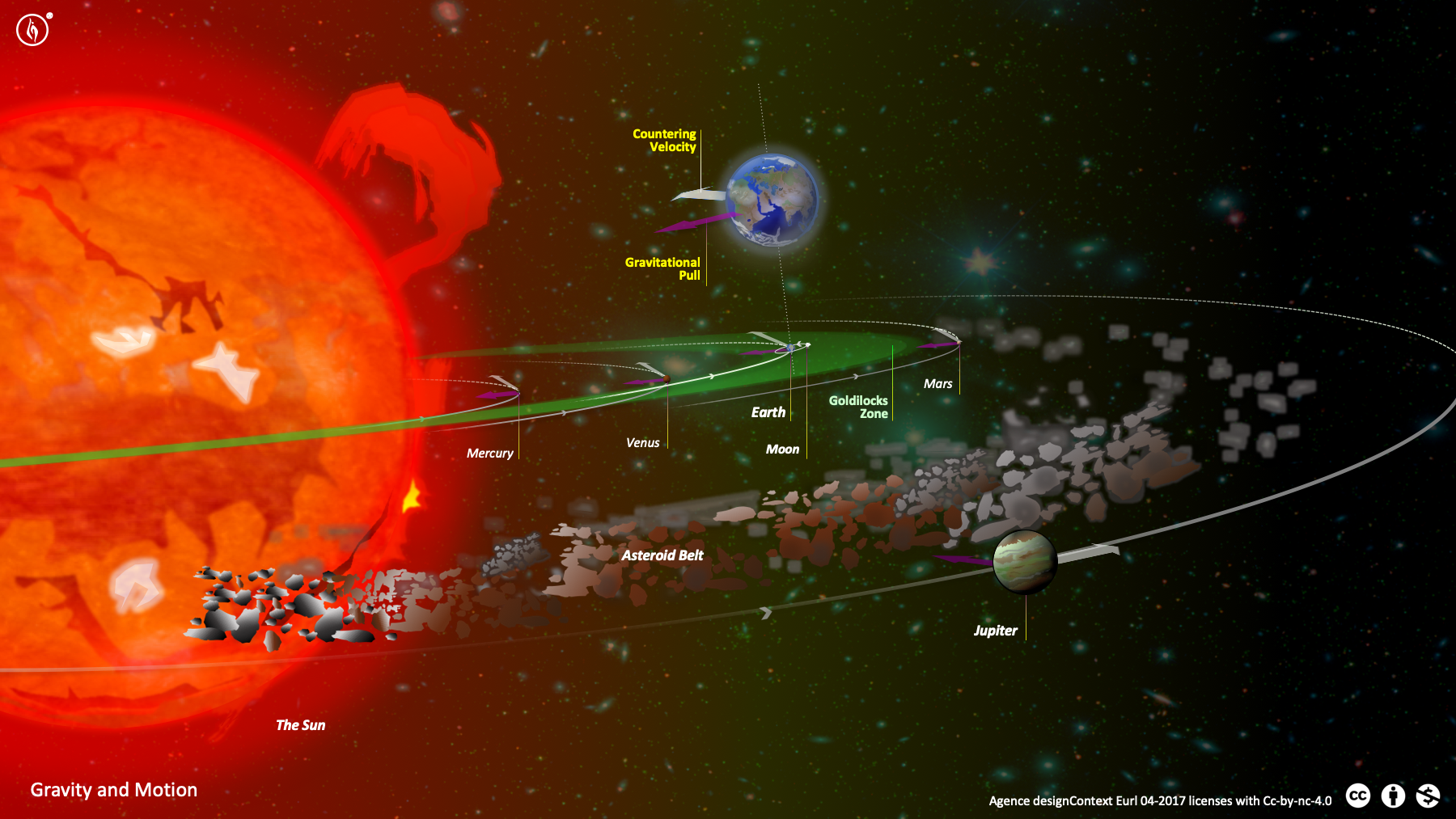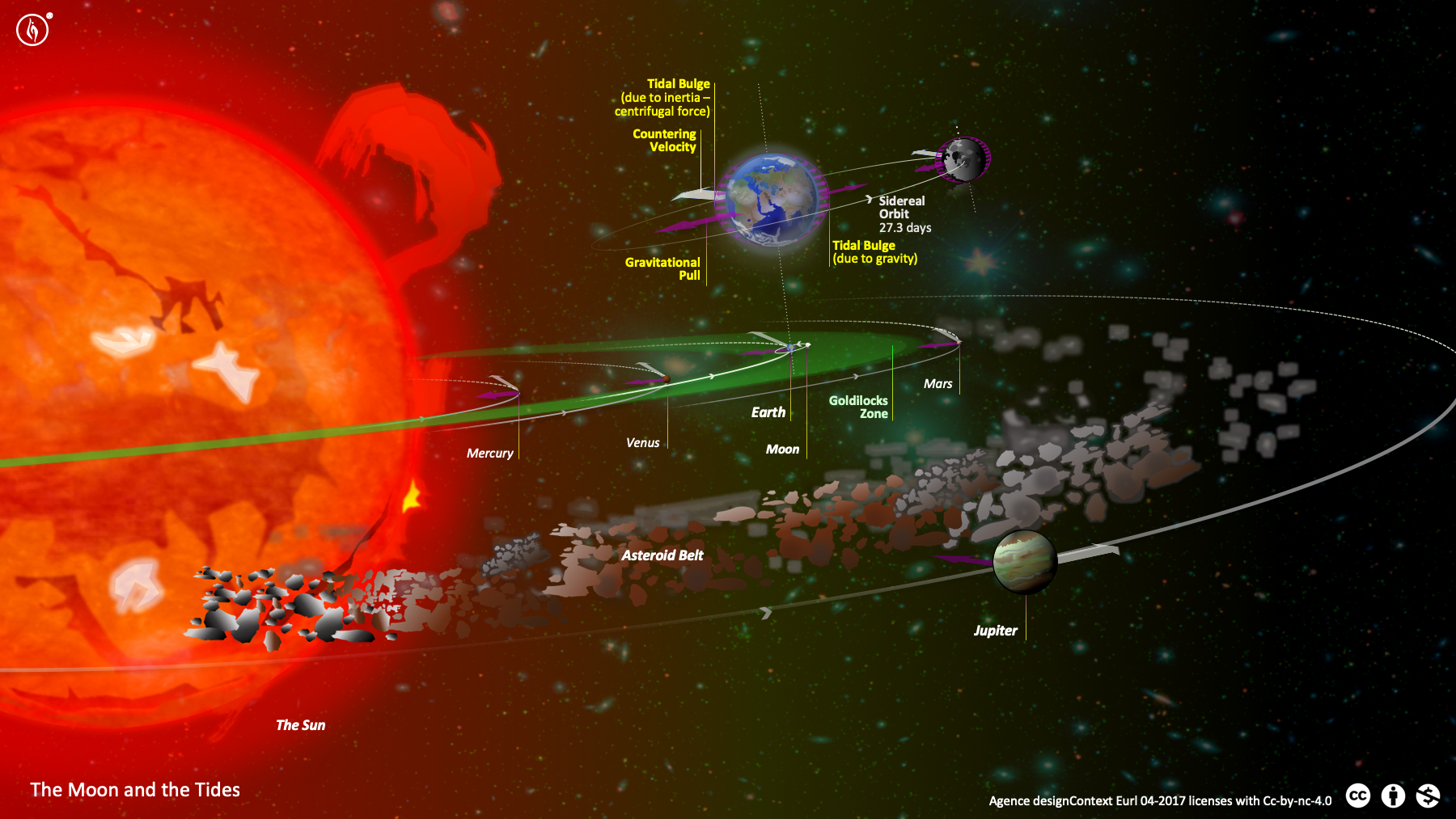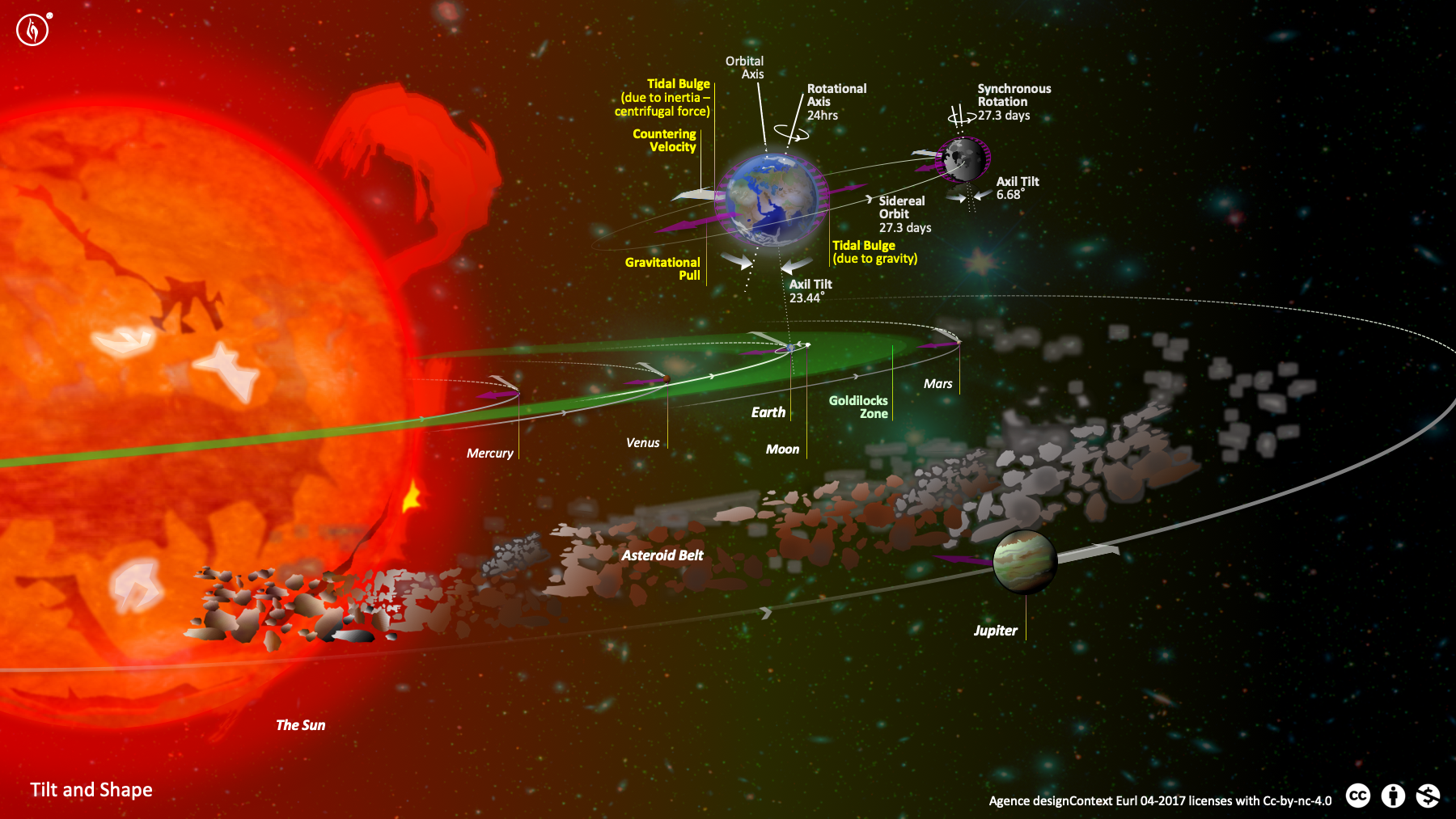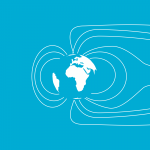Gravity
Gravity, the so called weakest ‘force,’ helps form all the stars and planets in the universe, maintaining them in their interactive orbits, and grasps all the collective rocks, liquids, and gases – and in the case of Earth, all life – retaining them together as whole planets or stars.


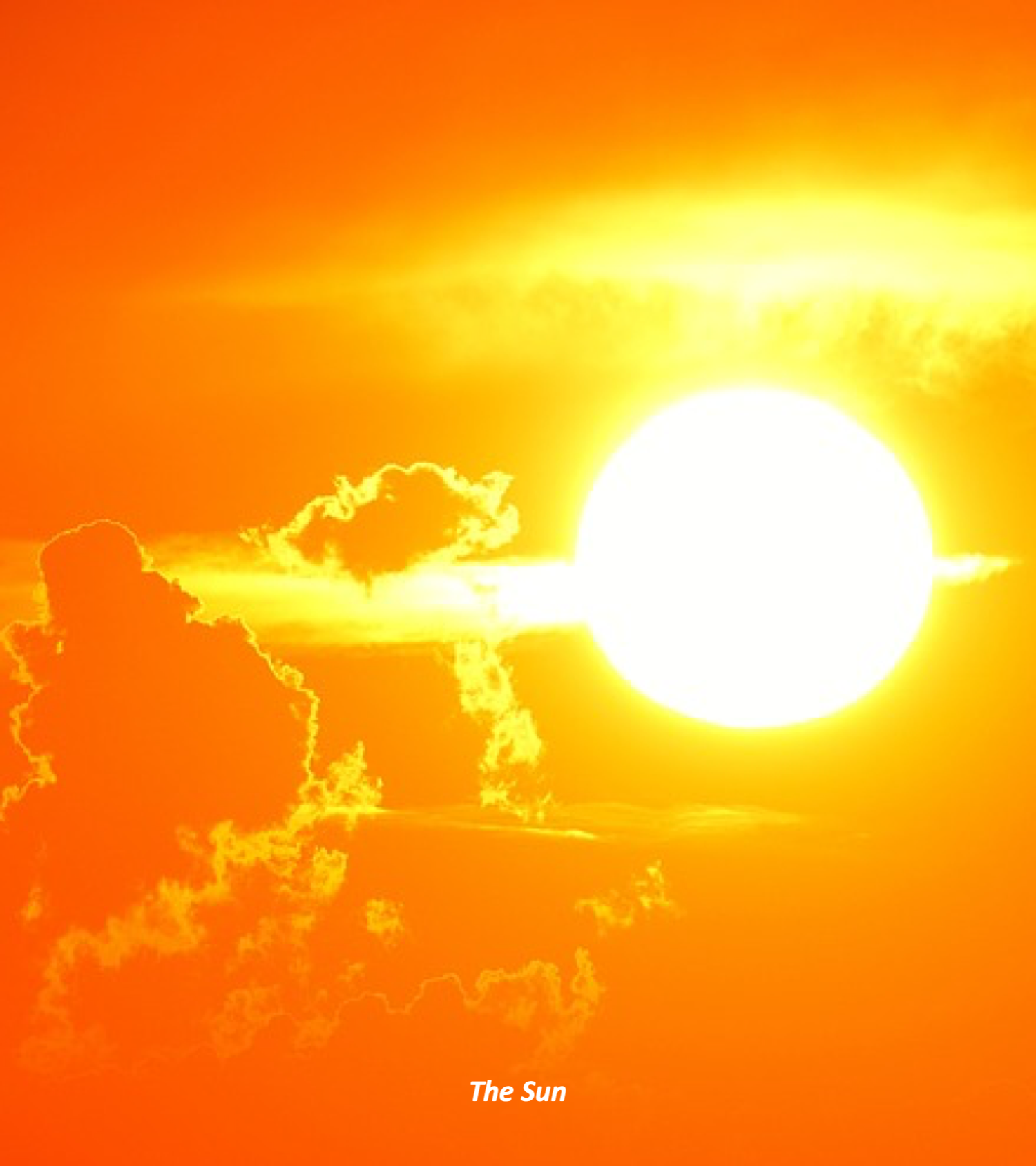
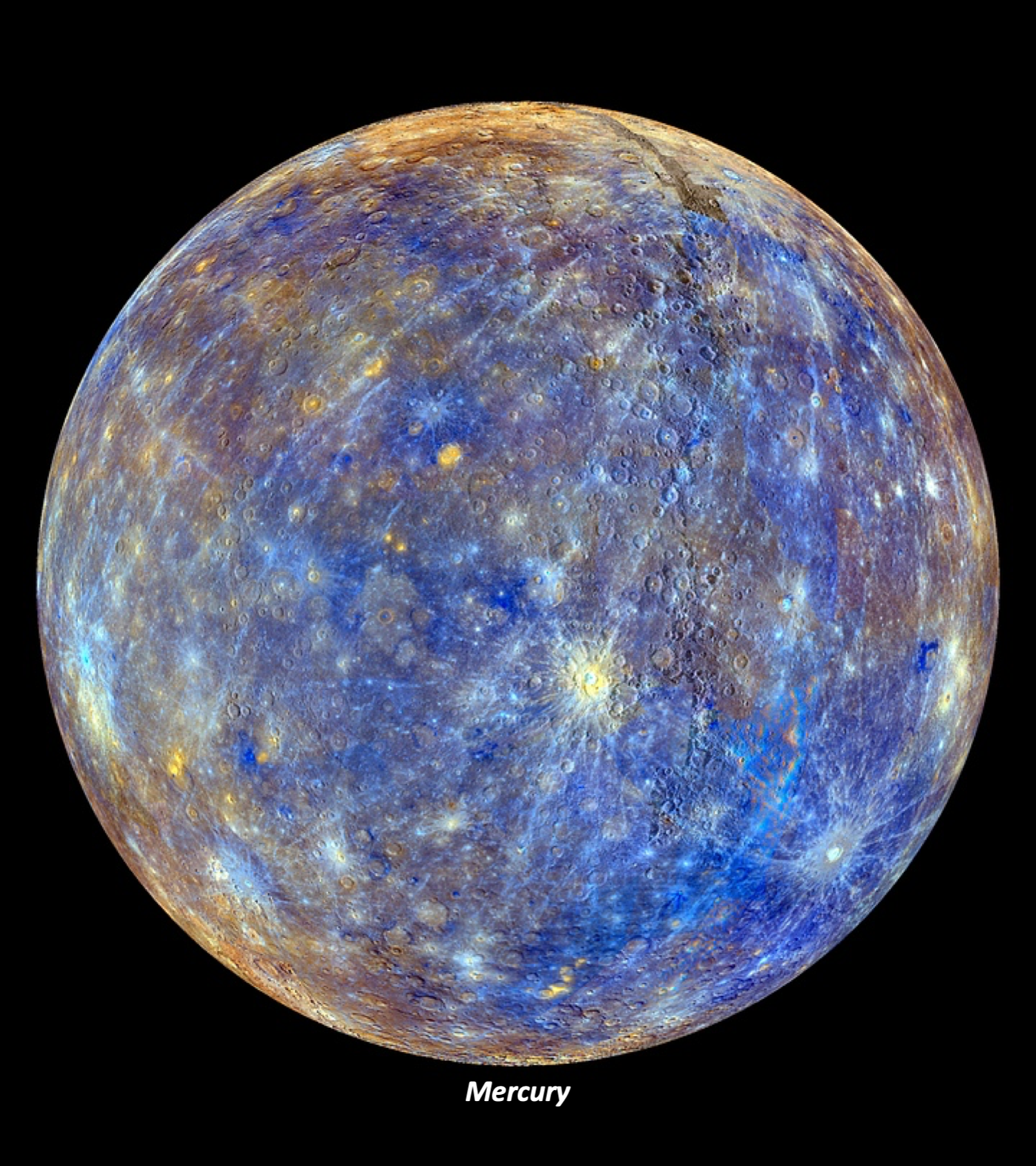
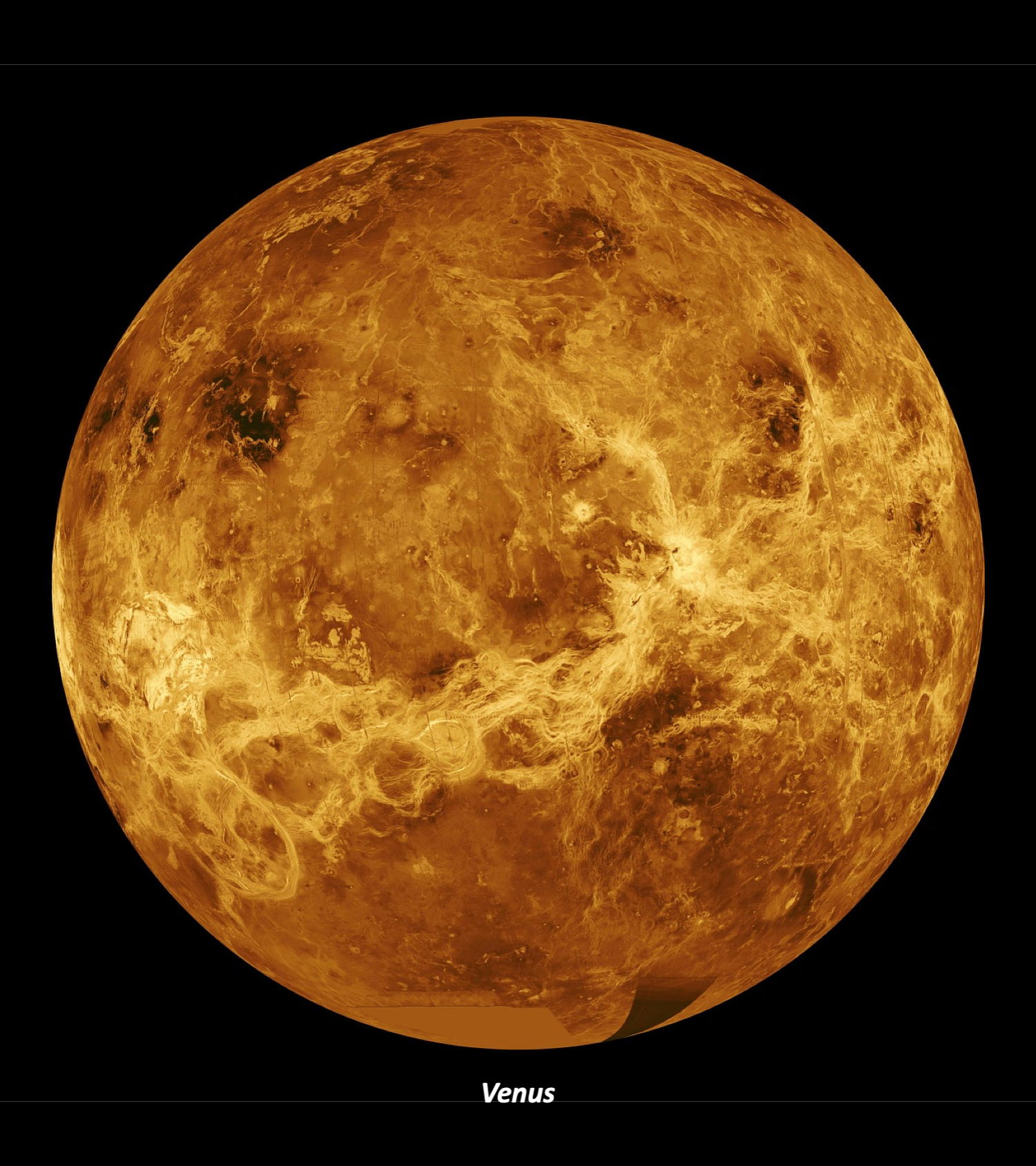
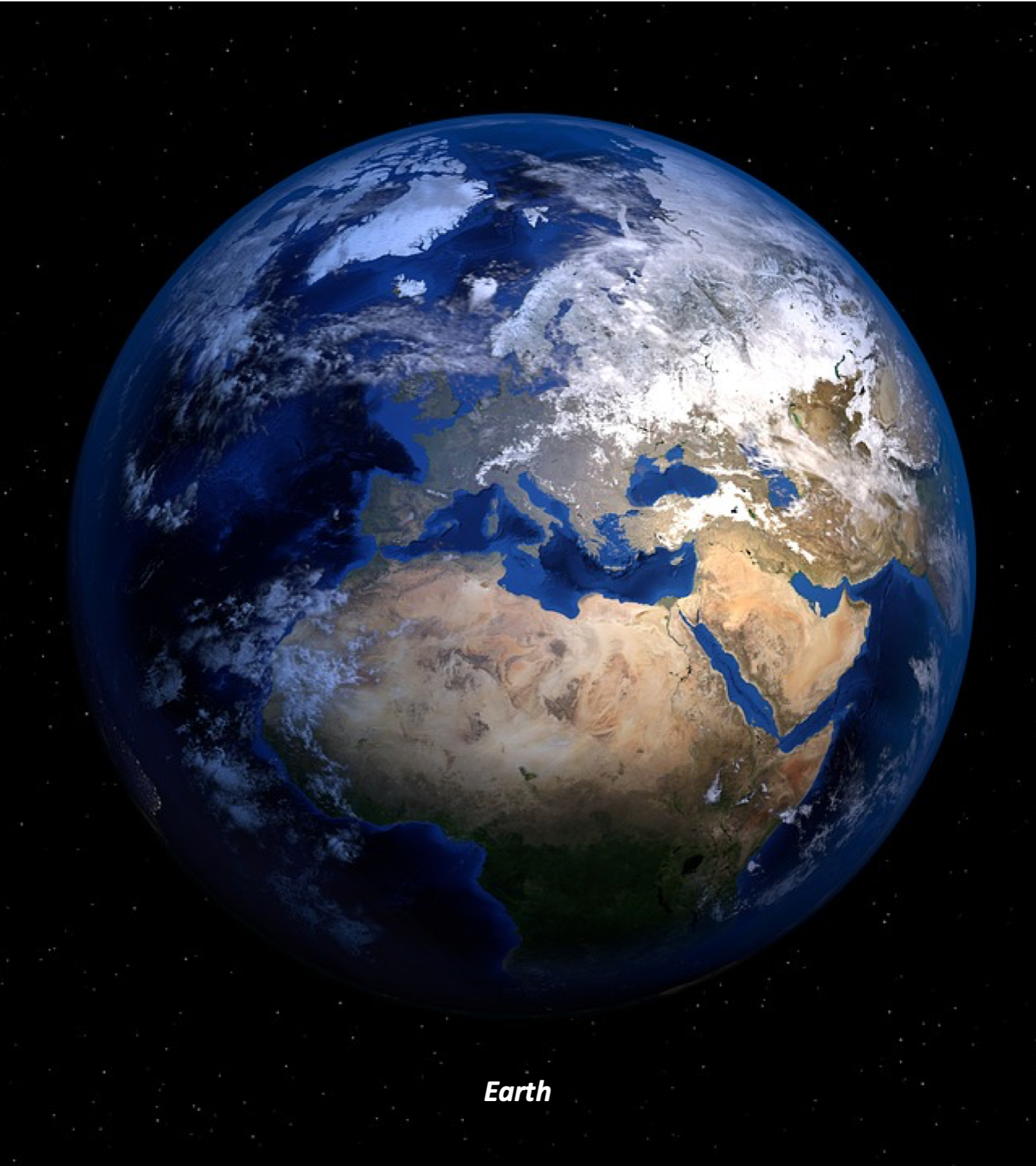
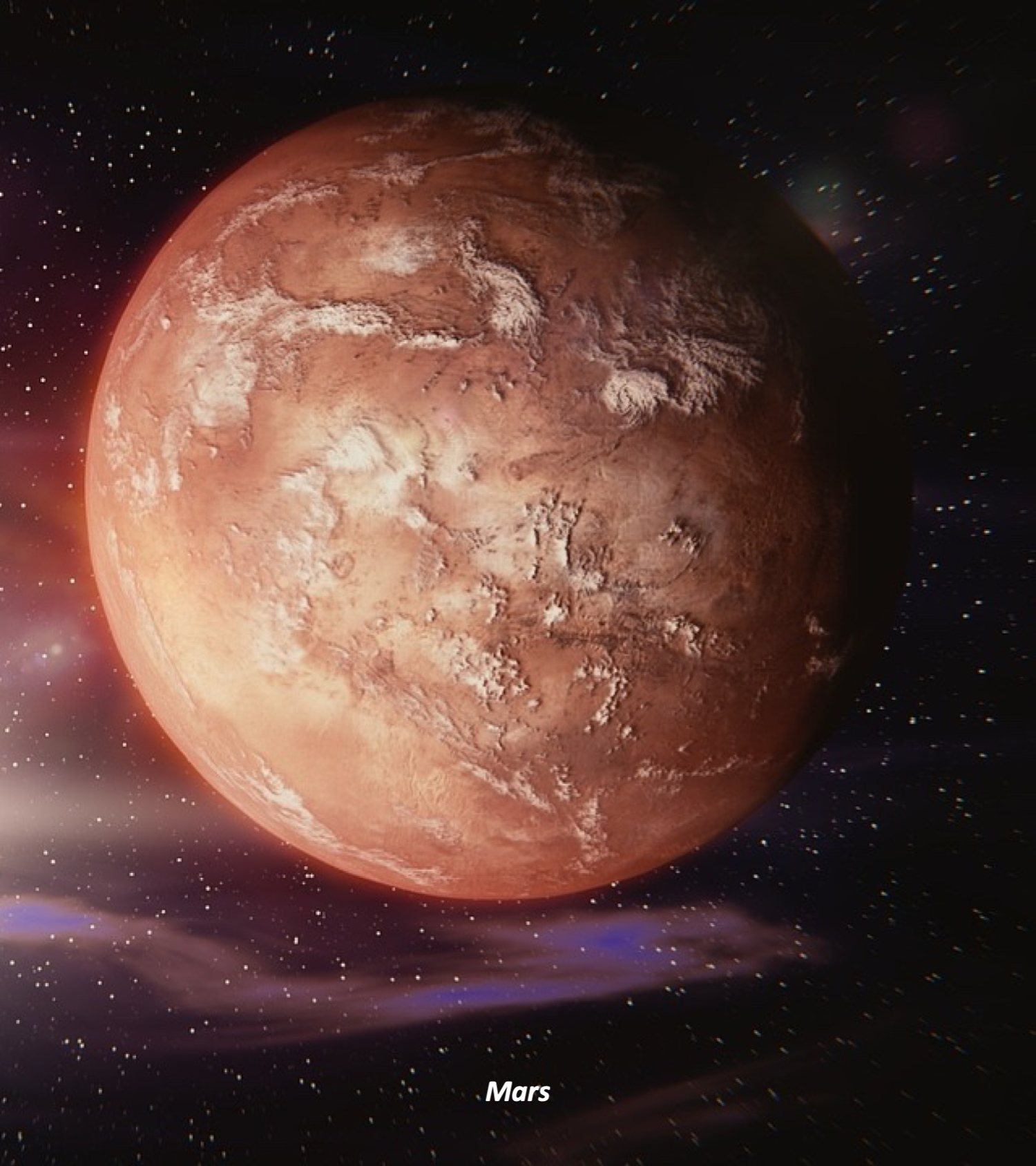
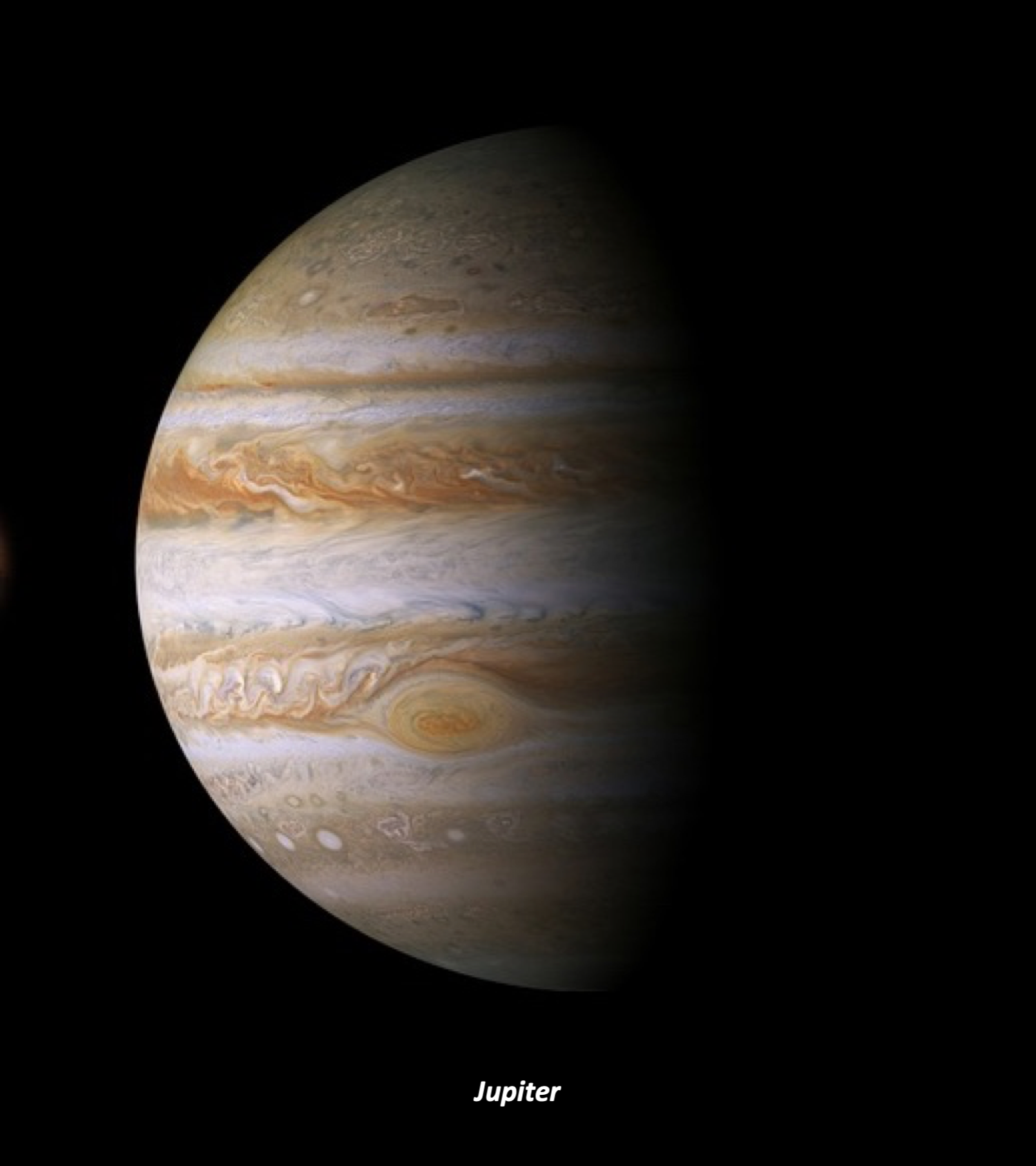
Getting our bearings…
The Sun
At the heart of our planetary system, is the Sun – our hydrogen burning star. Orbiting around it, all in the same counter-clockwise direction, are a number of rocks and planets. These are all orbiting practically in the same reference plane, and rotating about their axises in the same counter-clockwise direction (except Venus and variably Uranus).
Mercury
The closet planet orbiting the Sun is Mercury. It is the smallestplanet in the Solar System, which only takes 88 Earth days to complete its’ orbit. It has virtually no atmosphere, and surface temperatures can vary daily between -170 °C at night to over 400 °C during the day at the equator. Like the Earth, Mercury is classed as a Terrestrial Planet, as it has a rocky and metallic solid body.
Venus
The second planet from the Sun is Venus. It orbits the Sun every 224.7 Earth days, and rotates in the opposite direction to other planets (clock-wise); and it takes the longest time to rotate about it’s axis (243 Earth days). Like Mercury and Earth, Venus is also a Terrestrial Planet, with a similar size and mass to Earth. Venus has a dense atmosphere consisting of 96% carbon dioxide, and is the hottest planet in the Solar System, with an average temperature of over 460°C.
The Earth and the Moon
The third planet from the Sun is Earth. It orbits the Sun every 365.36 Earth days, and is the only ‘object’ in the known universe to harbour life (so far). The Earth and the Moon, are described in more detail in the section below, titled a ‘A Double Planet.’ And in relation to the other planets (including the moon, discussed more below), Earth is fortunate that their masses and configurations are as they are, because the:
“…mutual gravitational influences on each other and on the Earth produced the enduring emergent property of stability in the Earth’s orbit.” [1]
Mars
The fourth planet from the Sun is Mars. It orbits the Sun every 687 Earth days, and has a thin atmosphere, mostly of carbon dioxide – again 96%. And is the fourth (of four) Terrestrial Planets in the Solar System. Mars has two moons, ‘Phobos’ and ‘Deimos,’ and has water– although almost never in a liquid state due to the low atmospheric pressure; instead most of the water is held in polar ice caps and in underground ice.
The Asteroid Belt
Roughly positioned between Mars and Jupiter is the Asteroid Belt, which is a mass of rocky elements from 950km across to particles of dust. It is thought that the high gravitational energy of Jupiter has prevented these elements from forming together to make another planet. Of the 50,000 meteorites found on Earth thus far, 99.8% are thought to have come from the Asteroid Belt.
Jupiter
The fifth planet from the Sun, and the largest in the Solar System is Jupiter. With an atmosphere mainly composed of hydrogen and helium, it rotates around the Sun in 11.86 Earth years, and has the fastest axial rotation of all the planets – a dizzying ten hours. It is classed as a giant planet – the three others, the remaining Solar System Planets, Saturn, Uranus and Neptune are not shown. Jupiter is one-thousandth of the mass of the Sun, but is two and a half times the mass of all the other planets combined. And so, with this huge mass, and therefore huge gravitational field, Jupiter also influences the shape of the Solar System, and along with its 67 moons, it is believed by some astronomers to be the ‘vacuum cleaner’ of the solar system; partially shielding the inner planets from cometary bombardments (whilst sometimes deflecting some towards the inner planets).
References
[1] Harding, Stephan (2009 Second Edition) ‘Animate Earth: Science, Intuition, Gaia.’ Green Books, Cambridge, U.K.

Goldilocks Zone
Earth orbits the Sun at a significant distance, which places it within a zone known as the Goldilocks Zone – also known as the Habitable, Comfort or Circumstellar Habitable Zone (which also includes Mars, but not Venus). This zone, as its’ various names suggest, is an area in which it is theoretically possible for a planet, with sufficient atmospheric pressure (due to it’s mass), to maintain liquid water (and thus is limited to an average range within -15°C and 115°C). And as liquid water is essential for all known forms of life, planets within this zone are considered to be able to support life. If Earth was closer to the Sun, increased temperatures would trigger a ‘runaway greenhouse effect,’ and Earth would become like Venus today. If Earth was further from the Sun, reduced temperatures would mean that water would freeze (depending on the greenhouse effect), creating a ‘snowball Earth’.
Although the Sun is an incredibly reliable and constant source of light and heat, it has warmed-up, and continues to warm-up during its’ lifetime. It is estimated that the Sun is now around 25 per cent hotter since life began on Earth [3], but it still remains ‘just right’ for life. And so, it has been hypothesised that Earth has actually shifted out of this ‘goldilocks zone,’ that was previously based purely on physics, and is now being collectively maintained through:
“…a self-regulating system made up from the totality of organisms, the surface rocks, the ocean and the atmosphere tightly coupled as an evolving system. The theory sees this system as having a goal – the regulation of surface conditions so as always to be as favourable as possible for contemporary life.” [1]
This is known as the Gaia Theory.
[1] Lovelock, James (2006) ‘The Revenge of Gaia: Earth’s Climate Crisis & the Fate of Humanity.’ Allen Lane, A Member of the Penguin Group. U.K.
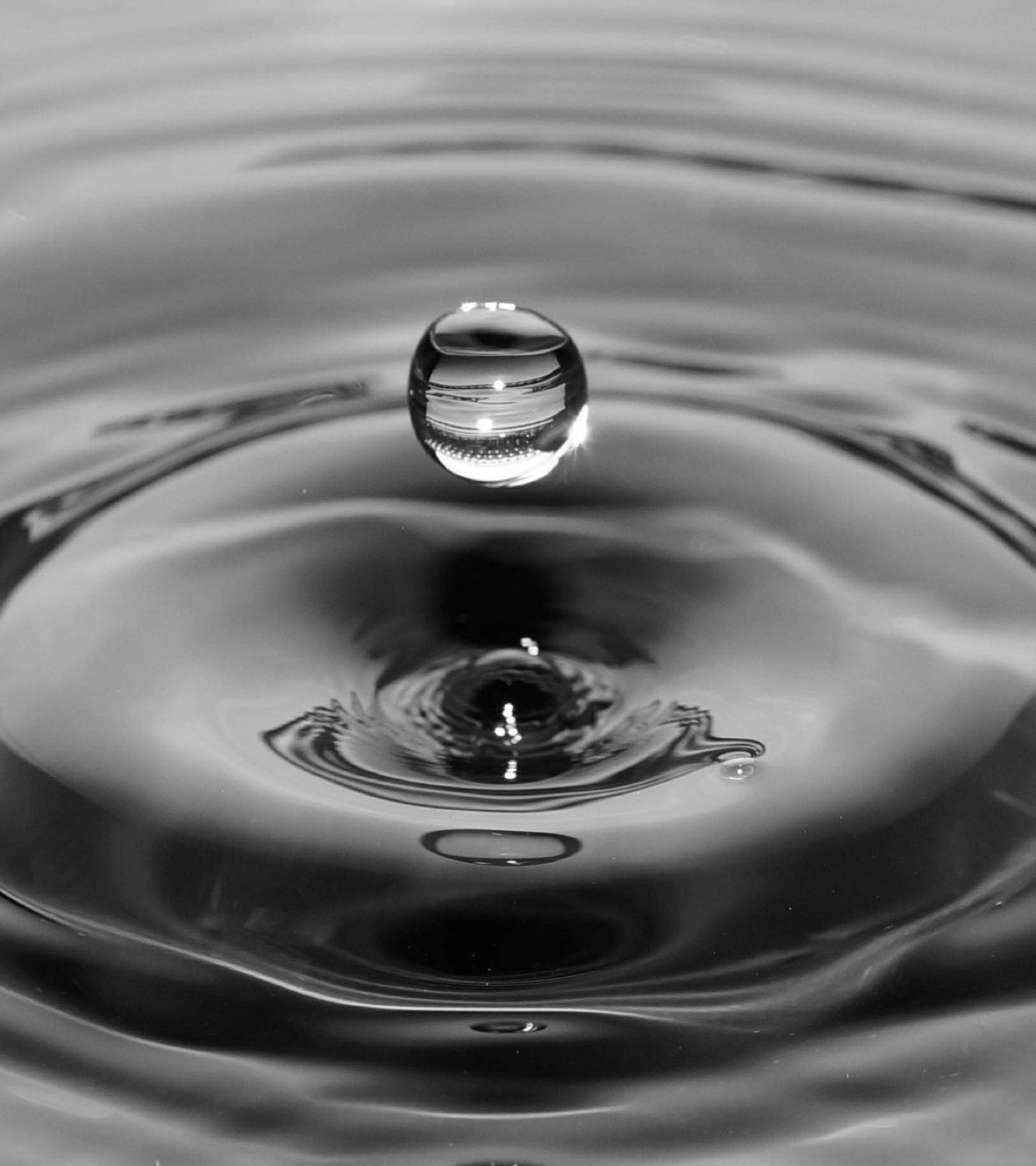

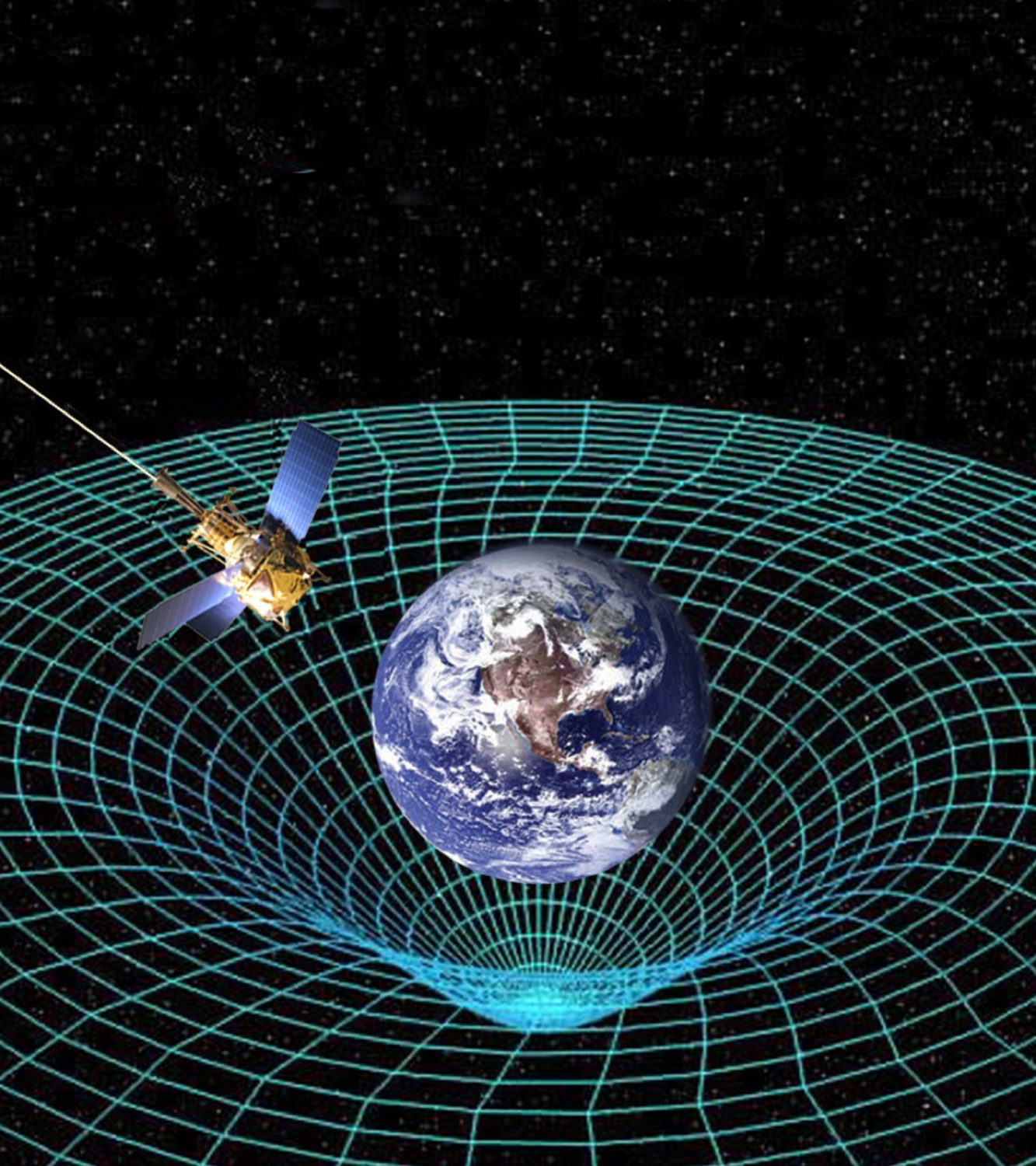
Gravity – The Curvature of Spacetime
“The biggest force that actually we are all subjected to, is the force of Gravity. It works 24hrs a day, the Sun, half the time. Gravity is the greatest force…” [1]
Gravity has built and created order in our solar system, galaxy and cosmos; forging dust and gas into stars and planets, and embracing them into interdependent orbits. Gravity on Earth is constantly reshaping, flowing water and nutrients downwards, eroding and pulling down mountains – dust, particle, rock by rock, and changing landscapes. But what is Gravity?
Gravity is a so-called ‘weak’ force, is one of four fundamental forces, and is the force of attraction that exists between all objects, which is proportional to their mass. This force between us and Earth, keeps us and our atmosphere, for instance, from floating out into space. Since it is proposed, through the equation E = mc2, by Einstein, that mass and energy are equivalent, then gravity also acts on energy (including light).
Gravity also works as a compressive force, acting on the mass of a planet or star for example. And like rain water wanting to flow downwards, all matter wants to flow downwards to the centre of the object – in this case a planet or star (always trying to move from a high potential energy state, to a low potential energy state). The ideal shape that allows this to happen is a sphere, and hence why planets and stars are round: not all objects in Space are round due to their mass – the greater the mass of the object, the greater the gravitational compressive forces ability to both compress and attract the outer surface to the centre to create a spherical form.
There is still much that is not fully understood about Gravity, but most current understanding is based around Einstein’s Theory of General Relativity. This is an explanation from Brian Cox:
“Gravity is the curvature of space-time [which is] the fabric of the Universe itself. What Einstein showed is that the presence of matter and energy – in the form of stars, planets and moons – curves the surface of space-time, distorting it into hills and valleys.” [2]
In the case of the Earth, our planet is falling into the valley of space-time created by the incredible mass of the Sun – the Gravitational Pull. And as Earth is trying to travel in a straight line perpendicular to the Sun – the Countering Velocity – maintains Earth caught in an orbit around the Sun. And what is true for the Sun and Earth, is true for all the planets in the solar system, the solar system within our galaxy, and all galaxies within the universe.
References
[1] Pauli, Gunter. (07/2011) ‘Changing the planet,’ Lift Conference
[2] Cox, Professor Brian (2011) ‘The Wonders Collection‘, BBC Series.


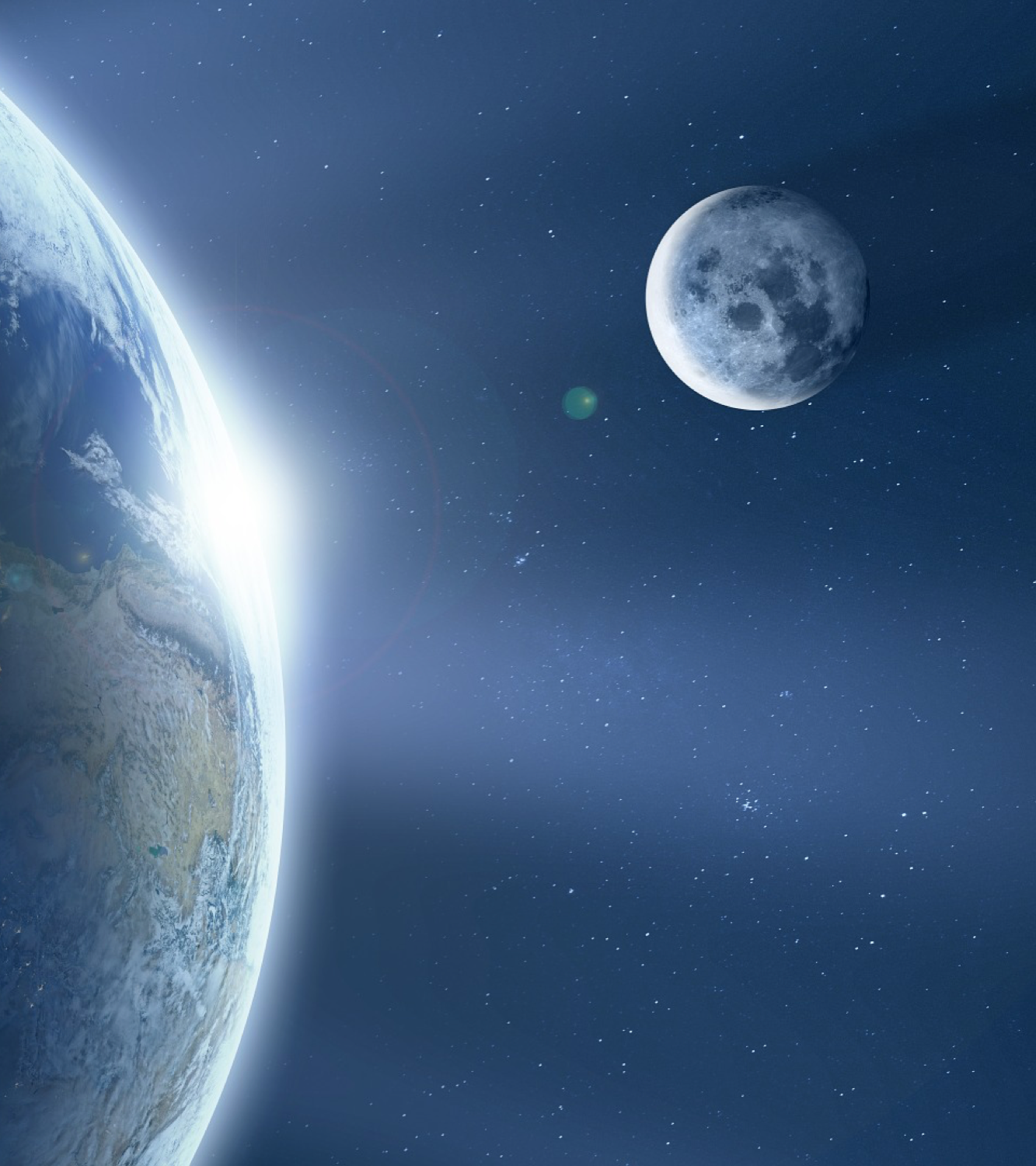
A Double Planet
It is hypothesised that the moon developed out of a interplanetary collision between the young Earth (over 4,000 million years ago) and a huge asteroid, potentially the size of Mars. Vast amounts of matter and energy were released, which later gathered together through gravitational forces to form the moon [1].
Scientific simulations suggest that at the time of its formation, the Moon was much closer than it is today (only around 22,000km away). And the Moon continues to enlarge its’ orbit away from the Earth at a rate of 3.78cm per year. In the very early years, the Moon stopped to rotate around it’s axis, due to the interactions between the tides of the Earth and Moon, and the transfer of energy via friction (known as tidal locking). This interaction also slows the rotation of the Earth, and also means that we always see the same side of the Moon.
The Moon is now orbiting at an average distance of 384,000 km. It is an unusually large satellite (Earth to Moon ratio 81:1), orbiting unusually close to Earth (their barycentre is 1750km below the Earth’s surface), and is close to Earth’s ecliptic plane. Predominately for these reasons, some astronomers state that it is in fact a Earth-Moon system – a double planet.
[1] Harding, Stephan (2009 Second Edition) ‘Animate Earth: Science, Intuition, Gaia.’ Green Books, Cambridge, U.K.

Tides
The gravitational attraction between the Moon and the Earth is the major cause of Tides. The Sun, although has a lesser influence, causes one much smaller tidal cycle per day, and when the three planetary bodies line-up, known as spring tide – when the Earth is influenced by both the Sun and Moon gravitational pull – tides are about 20% greater than average. When the Moon is perpendicular to the Sun, the high tides are at their lowest, known as neap tides. As a note ‘spring tide’ has noting to do with the season – instead it comes from the concept of “springing forth” – and occurs twice a month (as do neap tides), irrespective of the season.
During the Moon’s elliptical orbit of Earth (approximately every 27.3 days), it’s gravity pulls strongest at the side of the rotating Earth surface closest to it. This creates a rising “bulge” as the rock moves slightly (only a few centimetres), and the oceans move even more (as they are fluid) towards the moon (a few metres), creating a high tide. Whilst on the opposite side of Earth – the far side, the gravitational attraction (acceleration) is less as it is further away; and so here, inertia (the tendency to move in a straight line) is greater than the gravitational force, meaning that the ocean tries to keep going in a straight line, creating a bulge (and a high tide) in the opposite direction. Two low tides are consequently occurring at right-angles to the moon, at the mid-point between the high tides. As Earth rotates around its’ axis, it rotates through these bulges, which causes two lunar tides per day (in fact, tides are closer to 12.5 hours apart, as the Earth rotates around its’ axis, the moon is also rotating around the Earth).
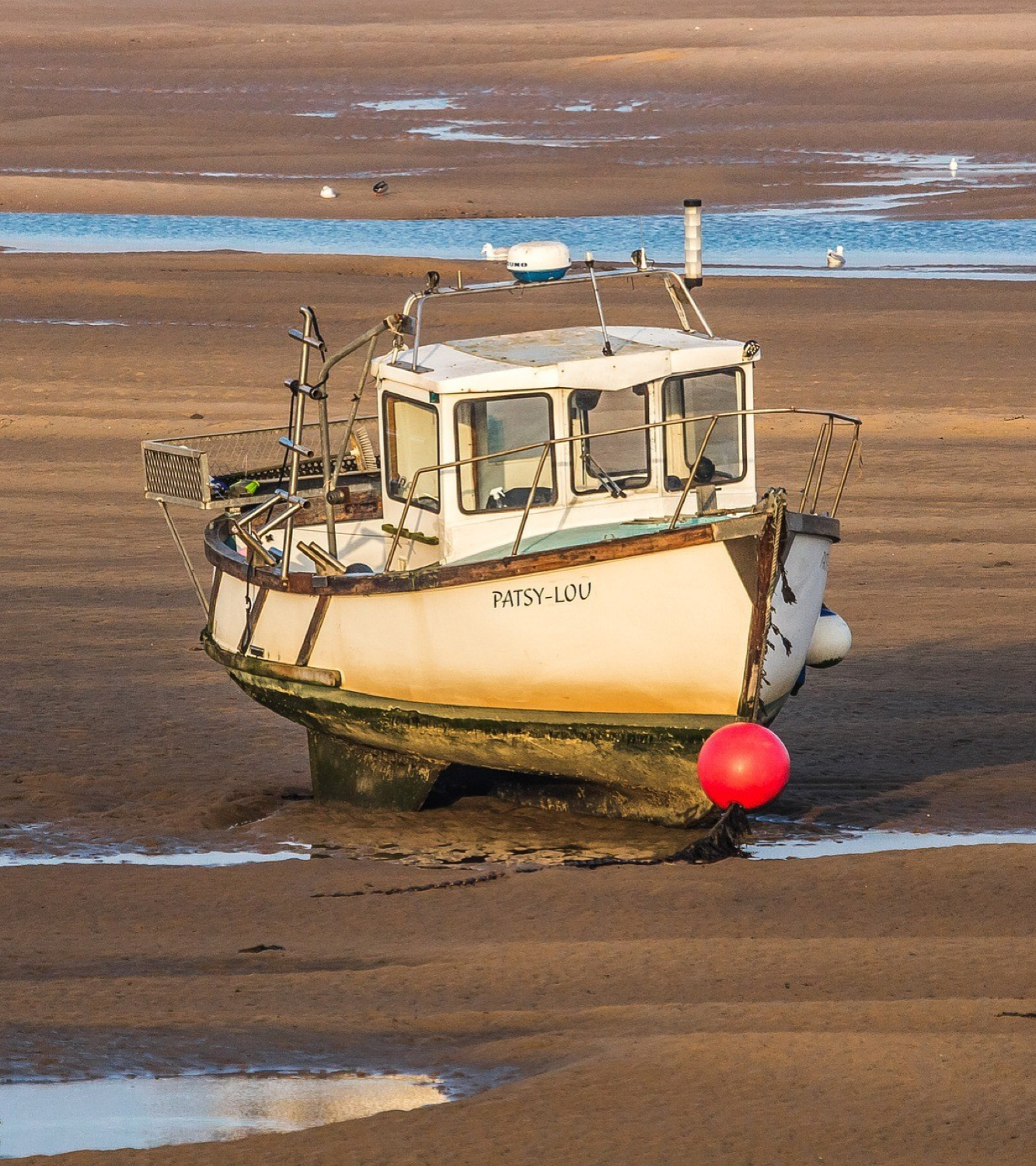
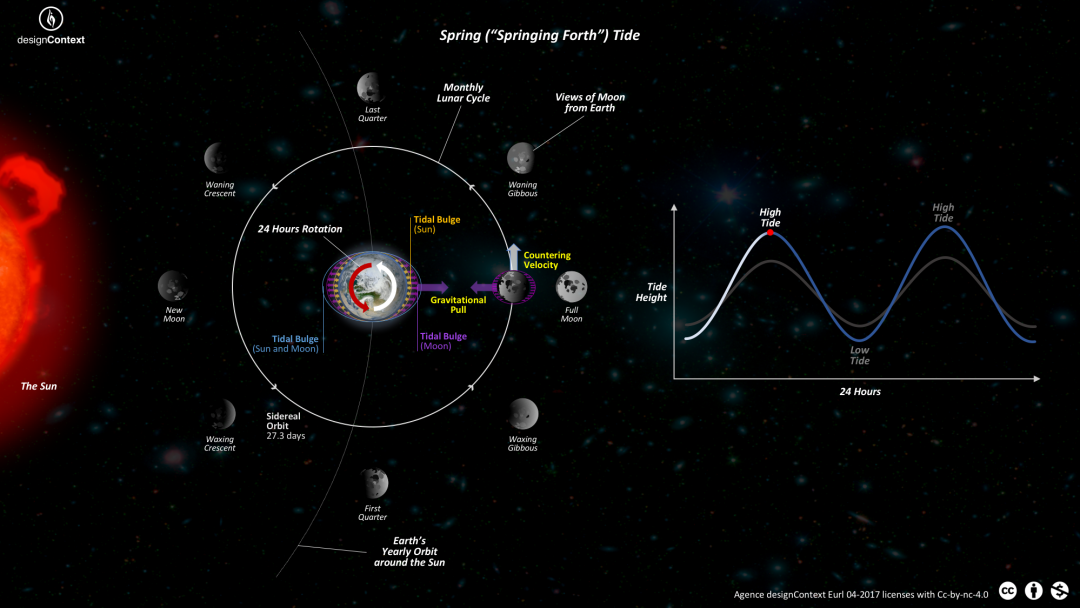
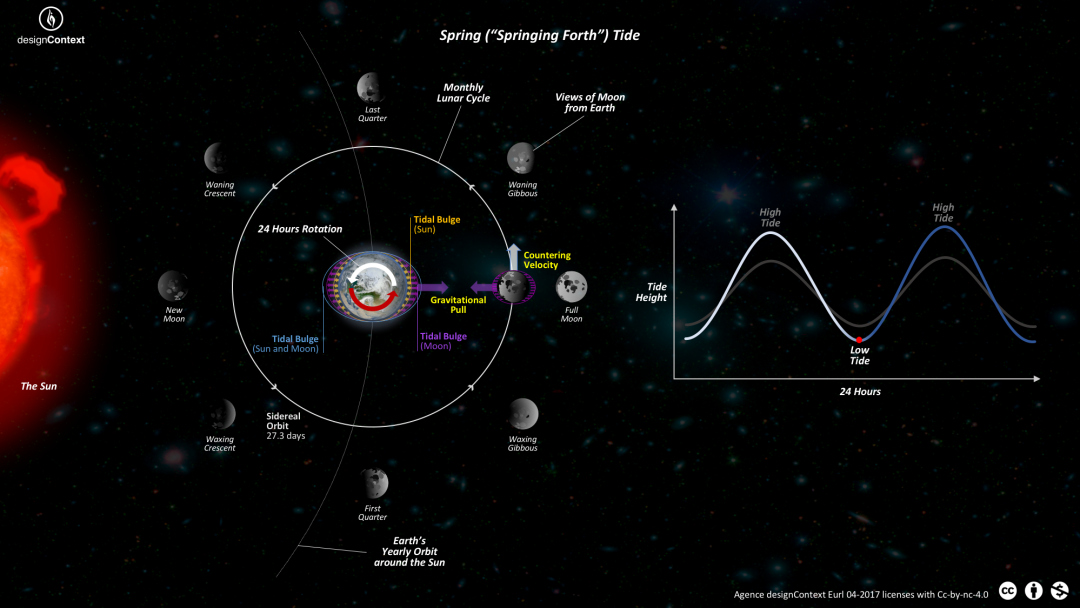
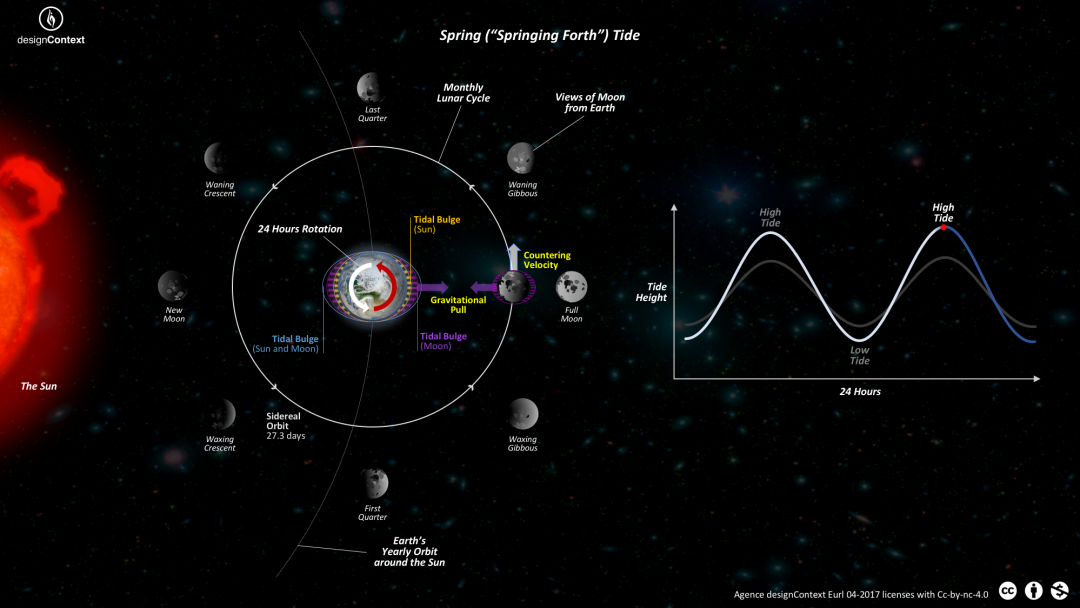
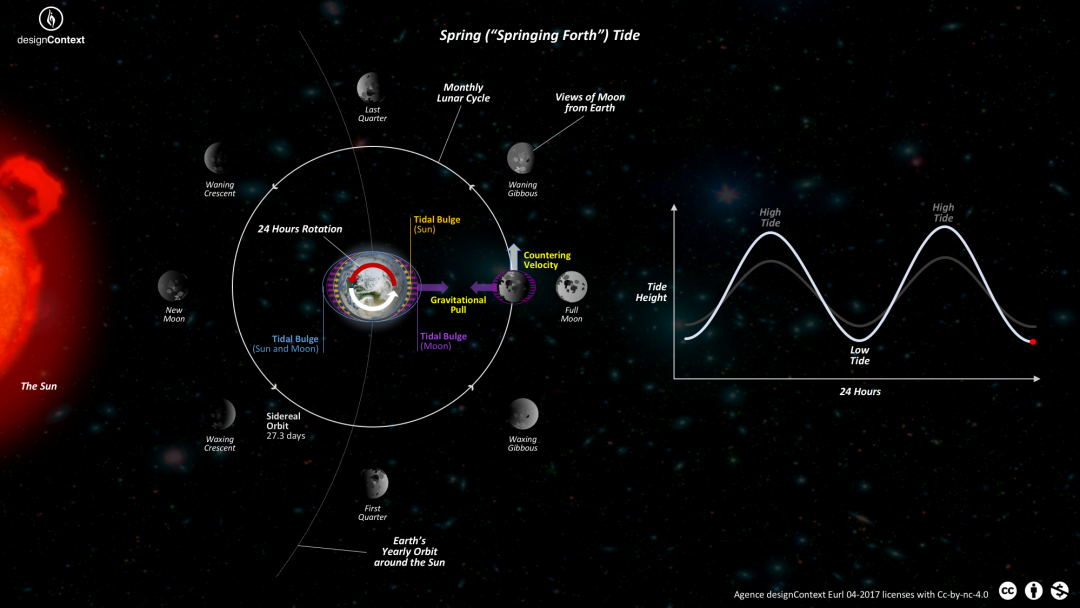
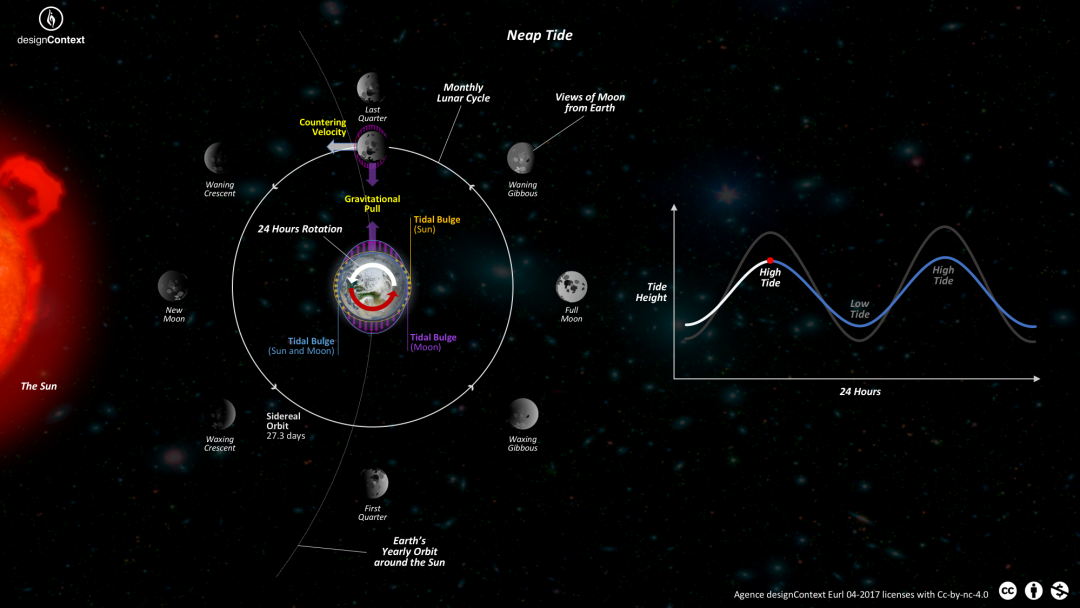
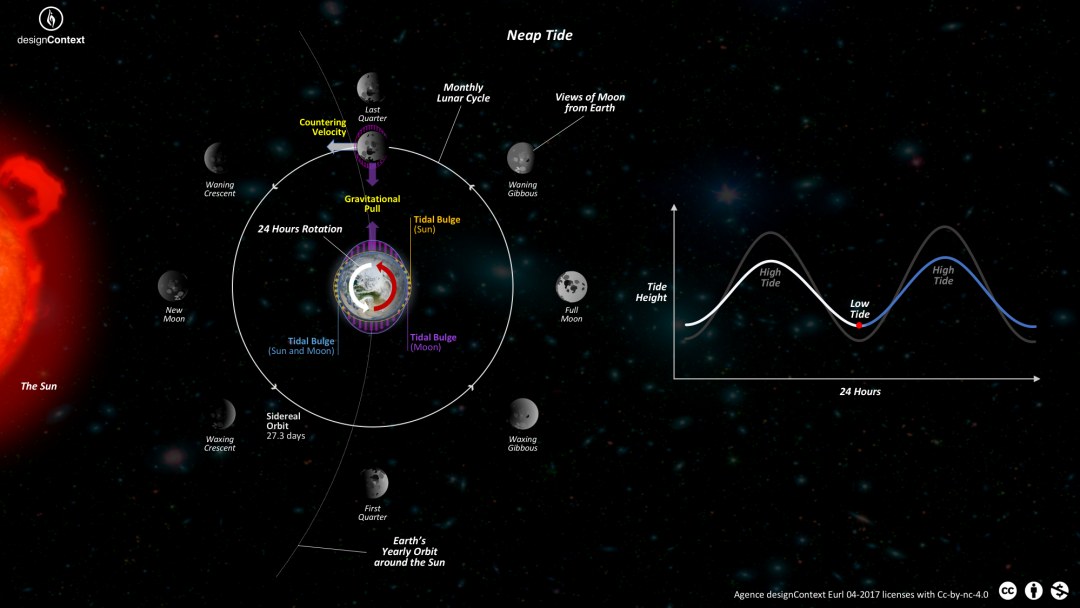
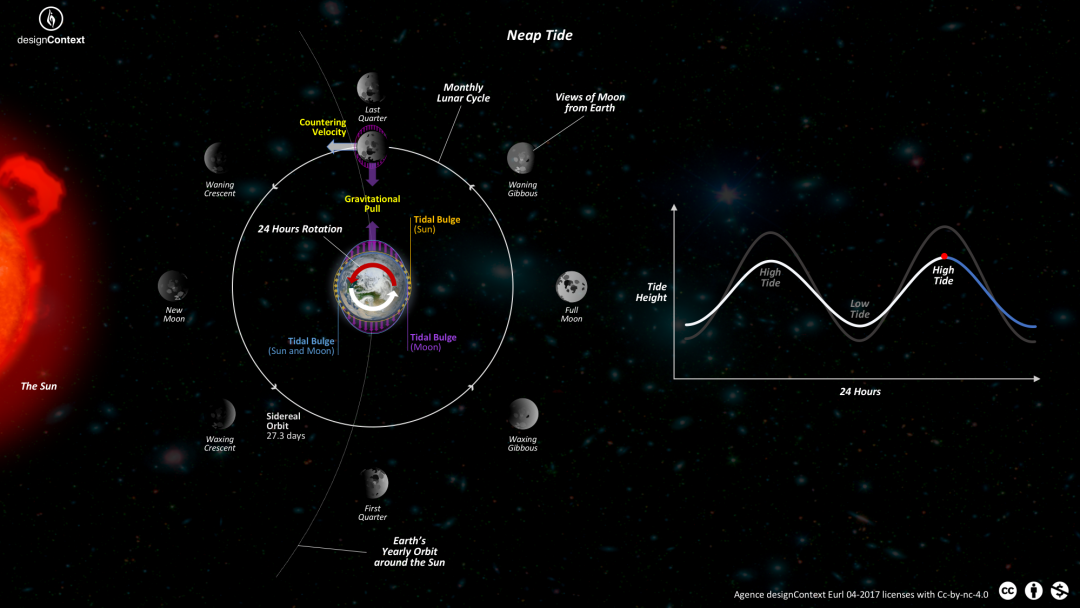
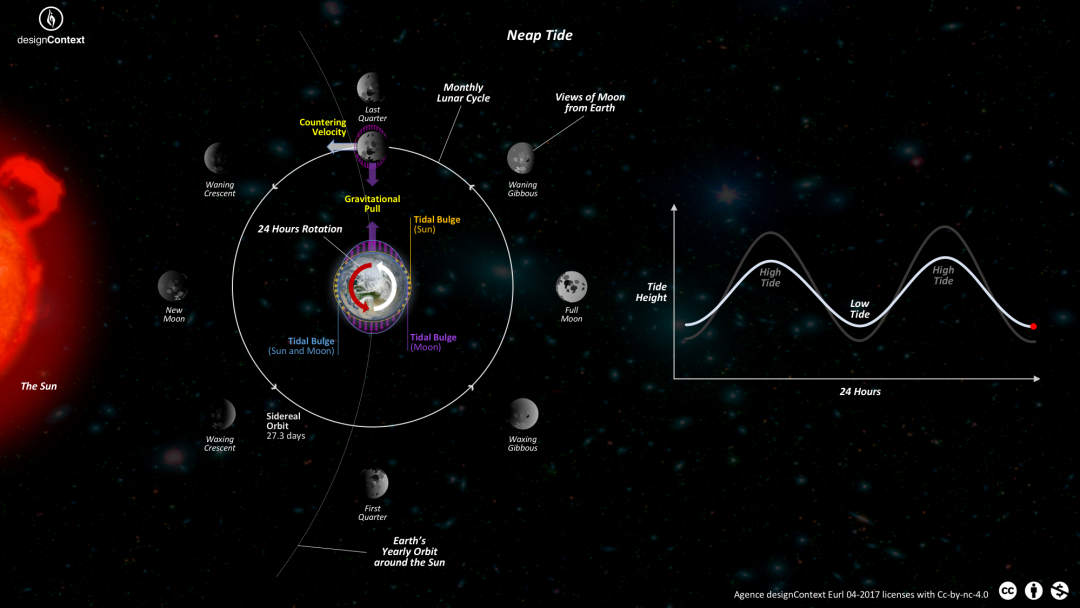
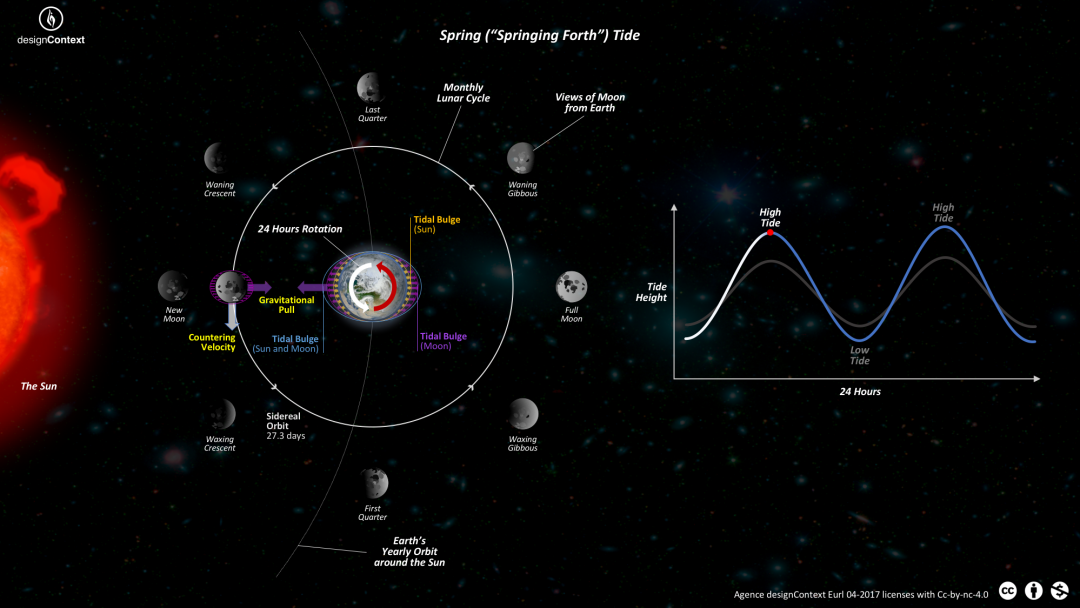
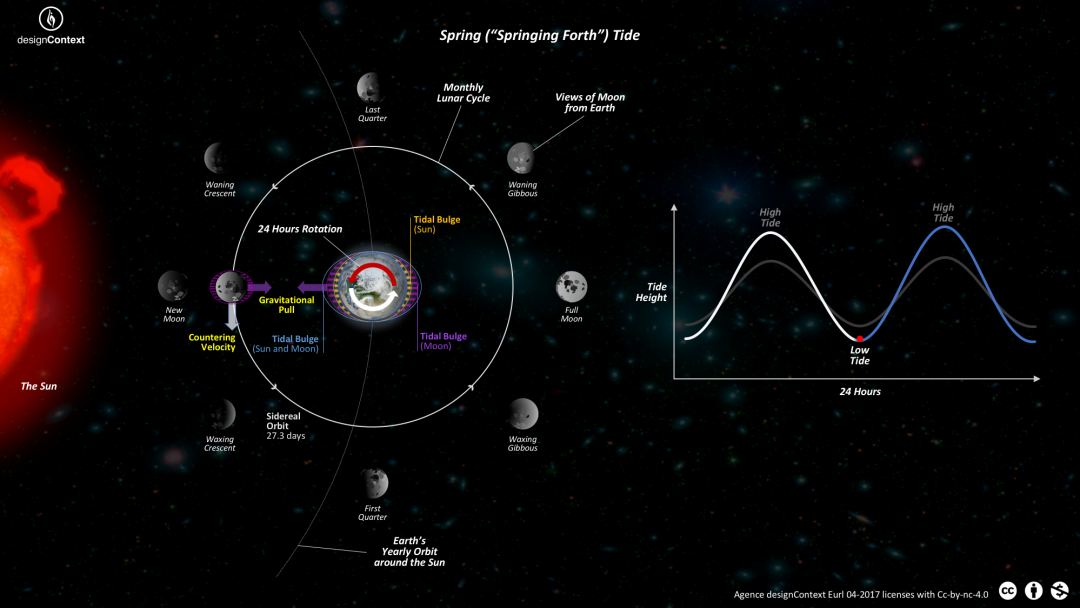
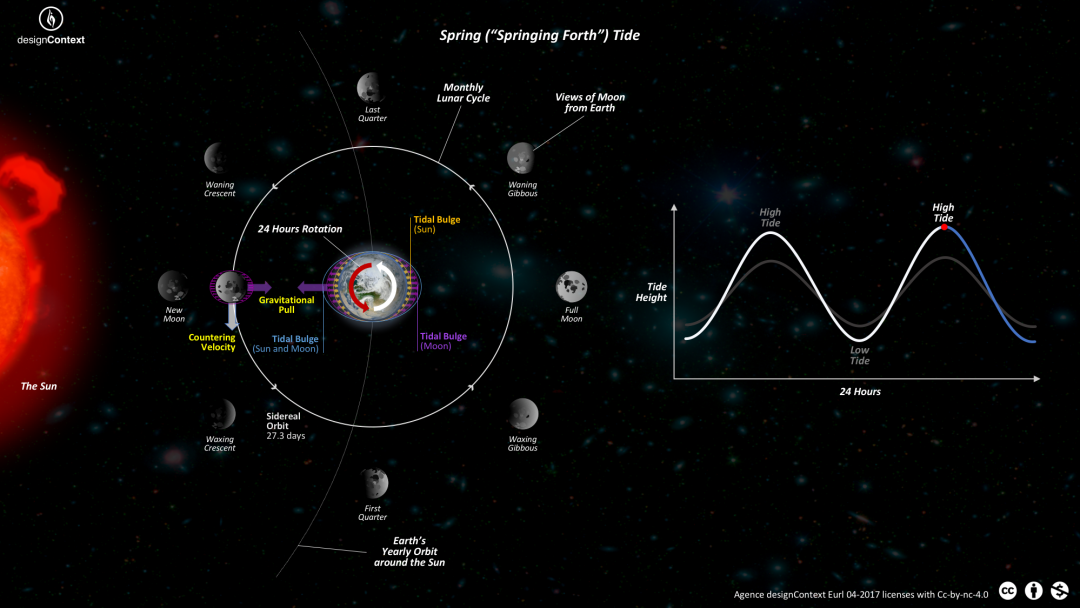
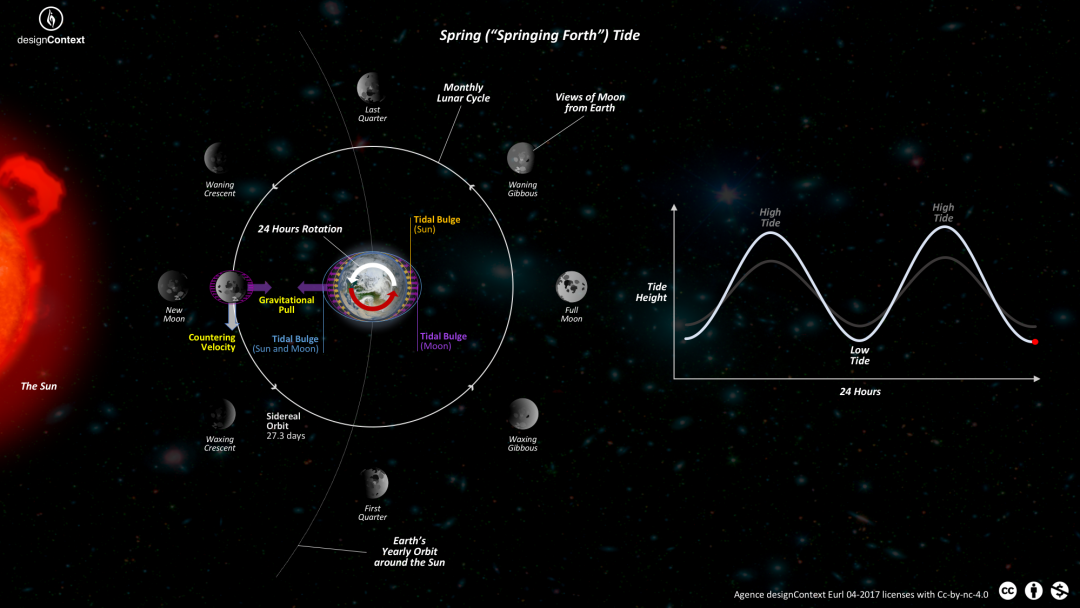
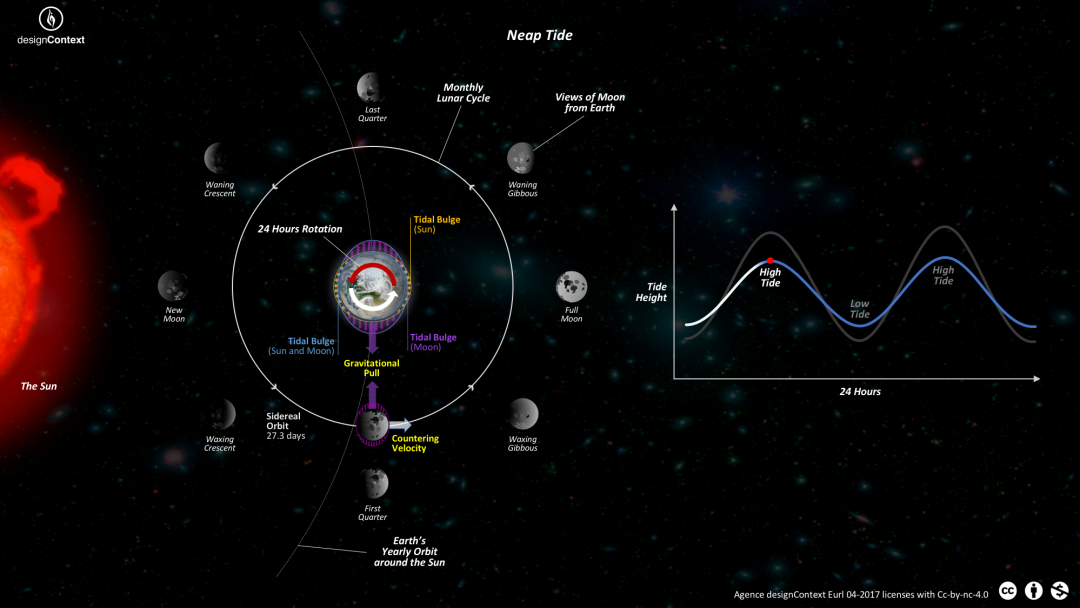
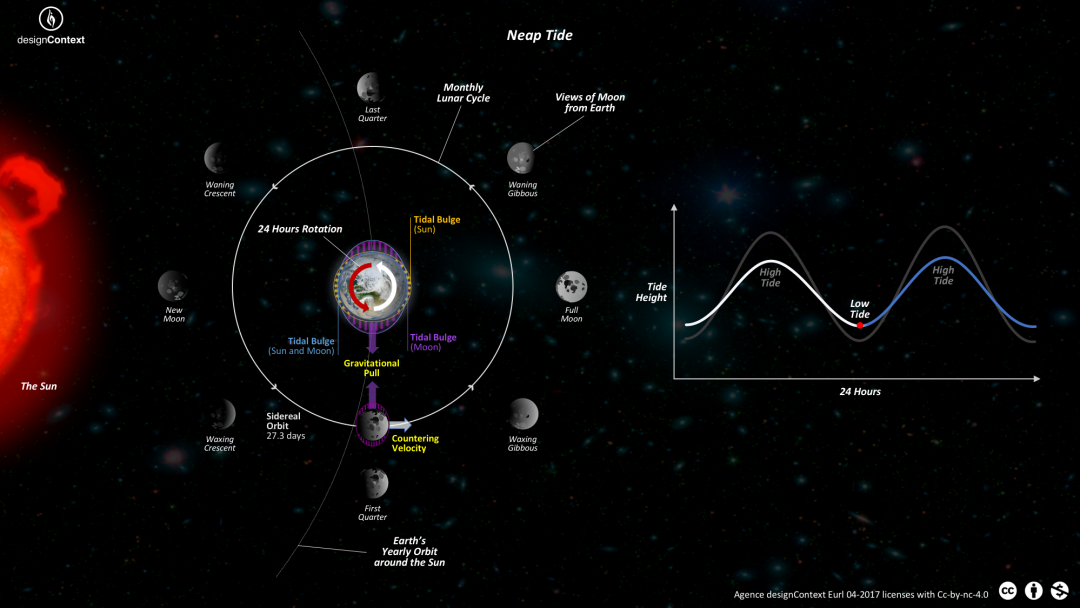
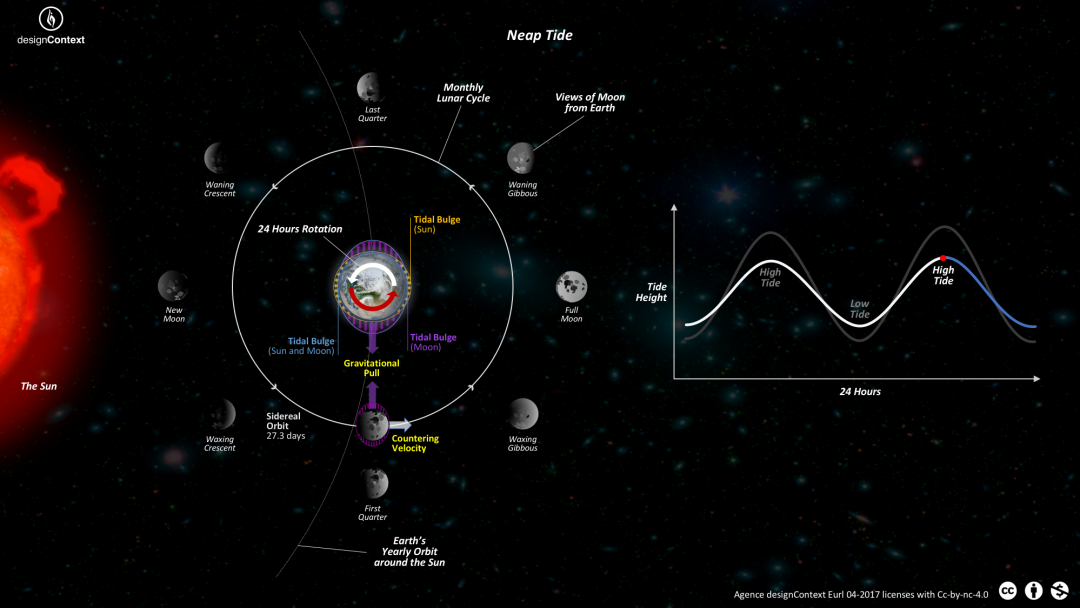
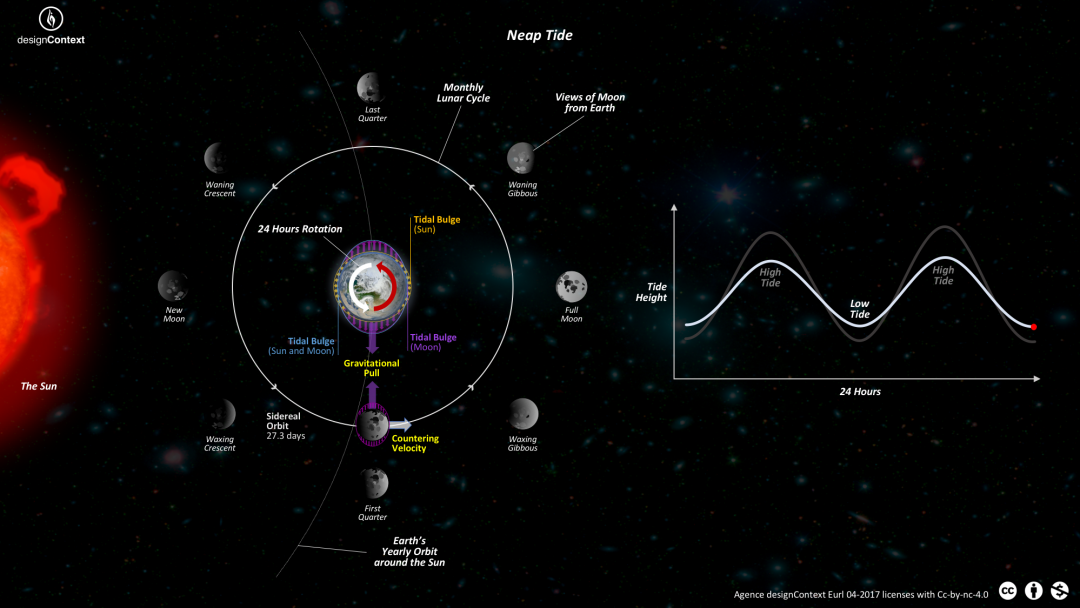
Figure 1: The interactive image above shows a idealised view of the tides, designed to illustrate the main concept. However, the Sun and Moon gravitational effects, also interact with other influences, such as the non-circular orbit of the Moon – when closer together (perigee) stronger than average tides, or when further away (apogee) – which also effects its attitude in the sky, the varying landscape of the Earth’s surface under the oceans (known as bathymetry); and the varying shapes of the coastlines. And so, some coastal areas experience semi-diurnal tides (two nearly equally high and low tides per fay), diurnal tides (one high and low tide per day), or mixed tides (two uneven tides per day – one high and one low). However, tide measurements can be taken at specific locations, and can be highly accurate and predictable – even although they may differ between locations.

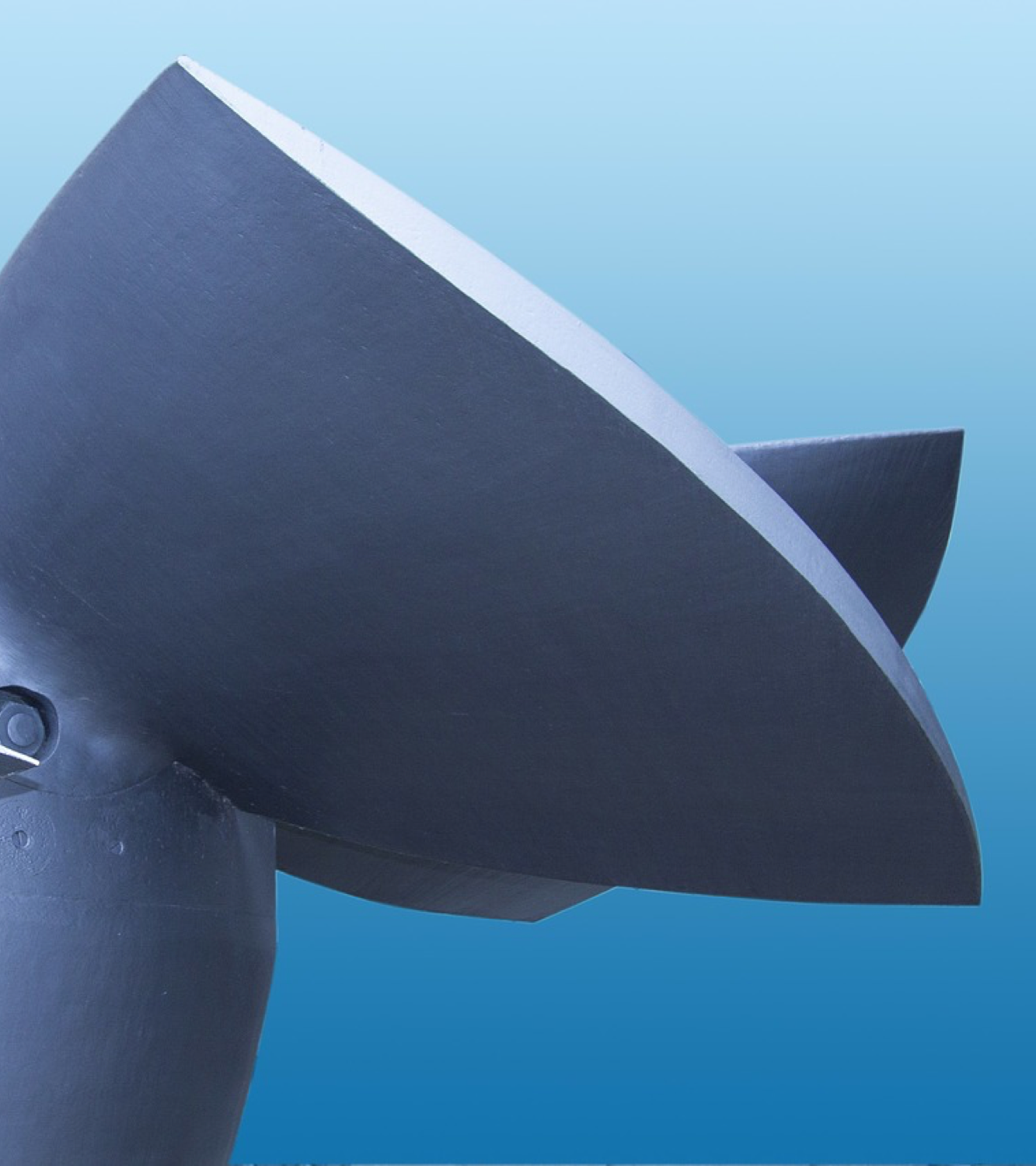
Tidal Power
Tidal power continues to be of interest, and reality, for the generation of renewable energy. Although, not without its’ complications, the main appeal is its constancy, which means that no storage is required – and its invisibility (under water)…
Various technologies are being used and developed, however most principally drive turbines, transforming the kinetic energy in the rising or falling, or back and forth of tidal cycles. One example is the Annapolis Royal Generating Station in Nova Scotia, which has the highest tides in the world (greater than 15 meters), due to the magnifying effect of its funnel shaped bay.

Rich Ecosystems on the Edges
Tides also help stir up chemicals, spread nutrients, and contribute to ocean currents, which help moderate global temperatures by transporting heat away from the equator towards the poles. And it is also believed that tides helped provide the necessary ecological testing ground between sea and land, for early species evolving out of the sea.
Seaweeds, many micro algaes, crabs, shrimps, mussels and sea snails, for instance, all live in these intertidal ecology zones. These abundant ‘edges,’ are where forms of life have co-evolved to take advantage of the challenges in changes in depth, such as desiccation (drying out) and submersion. The ability for species to be able to cope with desiccation, also helps to form distinct vertical zones of specific species.
Many of the life in these areas have formed biological rhythms in tune with the tidal cycles, such as gestation and egg hatching; and such links to womens’ menstrual cycles (about one lunar month) may hint at our common decent from marine ancestors.
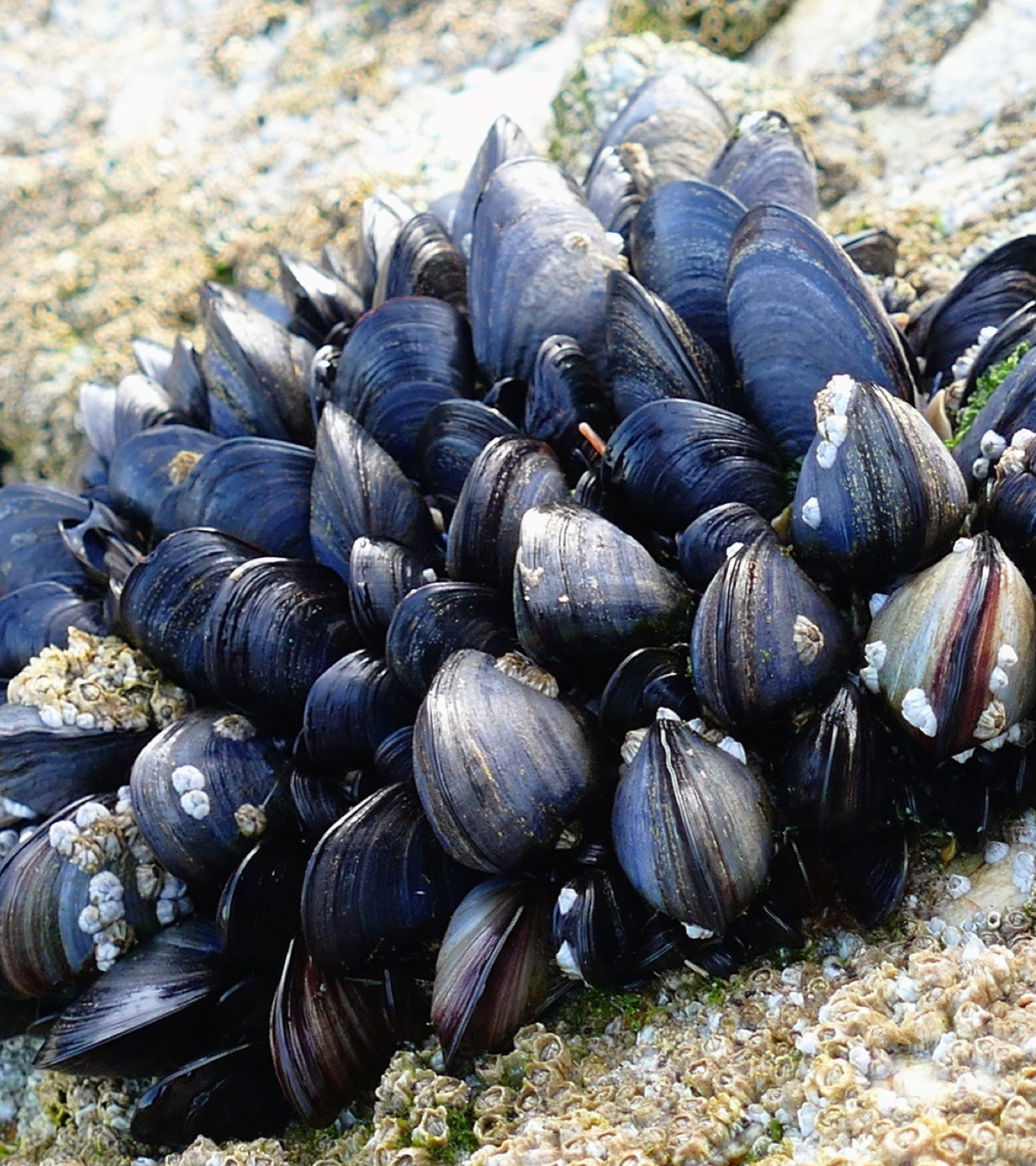


Gravity – Potential Energy
In the case of the Earth, our planet is falling into the valley of space-time created by the incredible mass of the Sun – the Gravitational Pull. And as Earth is trying to travel in a straight line perpendicular to the Sun – the Countering Velocity – maintains Earth caught in an orbit around the Sun. And what is true for the Sun and Earth, is true for all the planets in the solar system, the solar system within our galaxy, and all galaxies within the universe.
Rain clouds on Earth, or the water at the top of the water-fall, for instance, have Gravitational Potential Energy – GPE – (usually noted as Ug). The amount of energy, depends on the mass, and height above the surface of the Earth. When the rain falls from the sky for example, the GPE is transformed into kinetic energy, and can be transformed to do work.
Some coal-powered power stations pump water up into high dams in the mountains, during low energy demand, to store the potential energy until periods of high demand. When the stored water is released, it can be used to power hydroelectric generators. Innovative integrated wind-power with hydroelectric, or wind-hydro hybrid systems are also starting to be used and developed. Regenerative Agricultural design systems like Keyline Design®, can also use the topology of the land to catch water running off the landscape into catchment dams – at the highest points (the keypoint) on the landscape. By catching the water at the highest point, the water has the highest potential (on the landscape) to do work without pumps – and so the highest possible water pressure in any pipe systems leading from independent or inter-connected dams.
This company (in the video) is using gravitational energy to develop battery less lights (so no storage or life limit).

Buoyancy
Although the gravitational ‘force’ on the surface of the Earth is more or less constant, the mechanical load on land-life is around 1,000 times greater than in the water. Underwater, gravity is almost cancelled-out by buoyancy:
“…the upward force exerted by a fluid that opposes the weight of an immersed object.” [1]
If a body is lighter (less dense) than water, it will float. It floats as the body is experiencing an upward force that is equal to the weight of an equivalent volume of water, minus the weight of the body. If a body is denser than water, it will sink.
Different rules in the sea – defying gravity
All sea animals are mostly made up of salt water (relative to their total mass), so they weigh very close to the same as an equivalent volume of water. This means that their apparent weight (mechanical load) is very close to zero. And so, although, life in the sea has to deal with other forces, such as high levels of drag and lift, it is this difference in mechanical load that has made it possible for the largest mammal (and animal) on Earth to evolve in the sea – the Blue Whale – and not on the land; and in essence, defy gravity. As a side note, Whales are mammals, meaning they need to breath air from the atmosphere, so they have adaptions, such as extremely high levels of haemoglobin in the blood and muscle cells, that means that when they deep dive, there is actually very little air in their lungs (which get compressed to a very small size, as the increasing weight of the water above presses down on them), and they are able to ‘breath’ from the oxygen resources in the blood cells and muscles and not from the compressed lungs.
Seaweed – a brown, macro-algae, such as kelp, develop into huge forests under the sea. These ecosystems are recognised as some of the most productive and dynamic ecosystems on Earth. Like the whale, the seaweed does not have to ‘deal’ with gravity, and so unlike land plants, seaweed doesn’t have to expend energybuilding complex support materials, such as lignin; and as it obtains all it’s nutrients from the sea-water that is all encompassing, it doesn’t need complex vascular (xylem and phloem) systems to transfer nutrients around, or roots – instead they have a short root-like mass, known as a holdfast for anchoring the thallus (the body) on to the sea floor. For these reasons, some seaweeds can grow faster than tropical bamboo (about 30cm per day for some species), and as such, can drawdown far more carbon dioxide from the atmosphere than land plants.
References
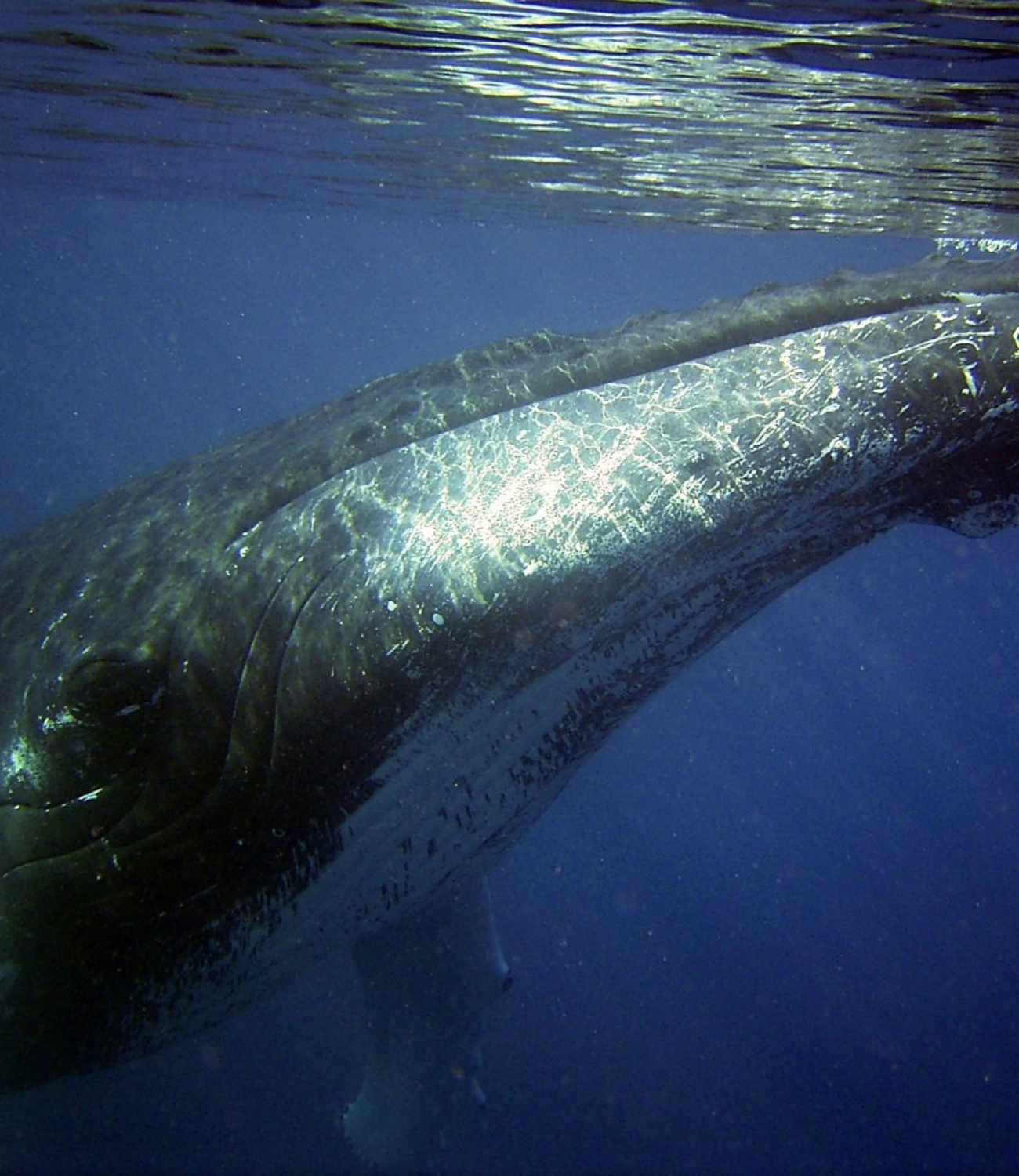
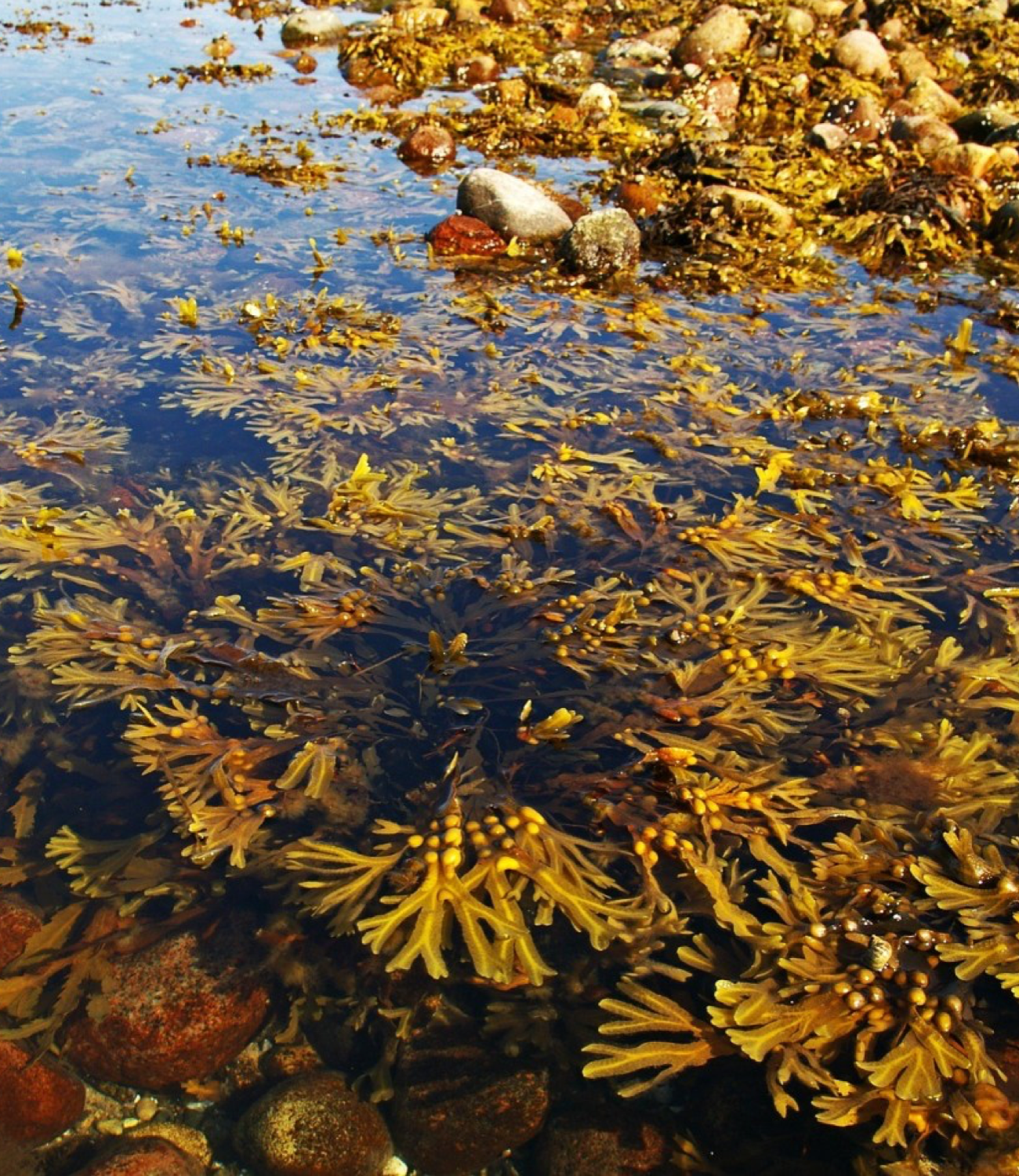

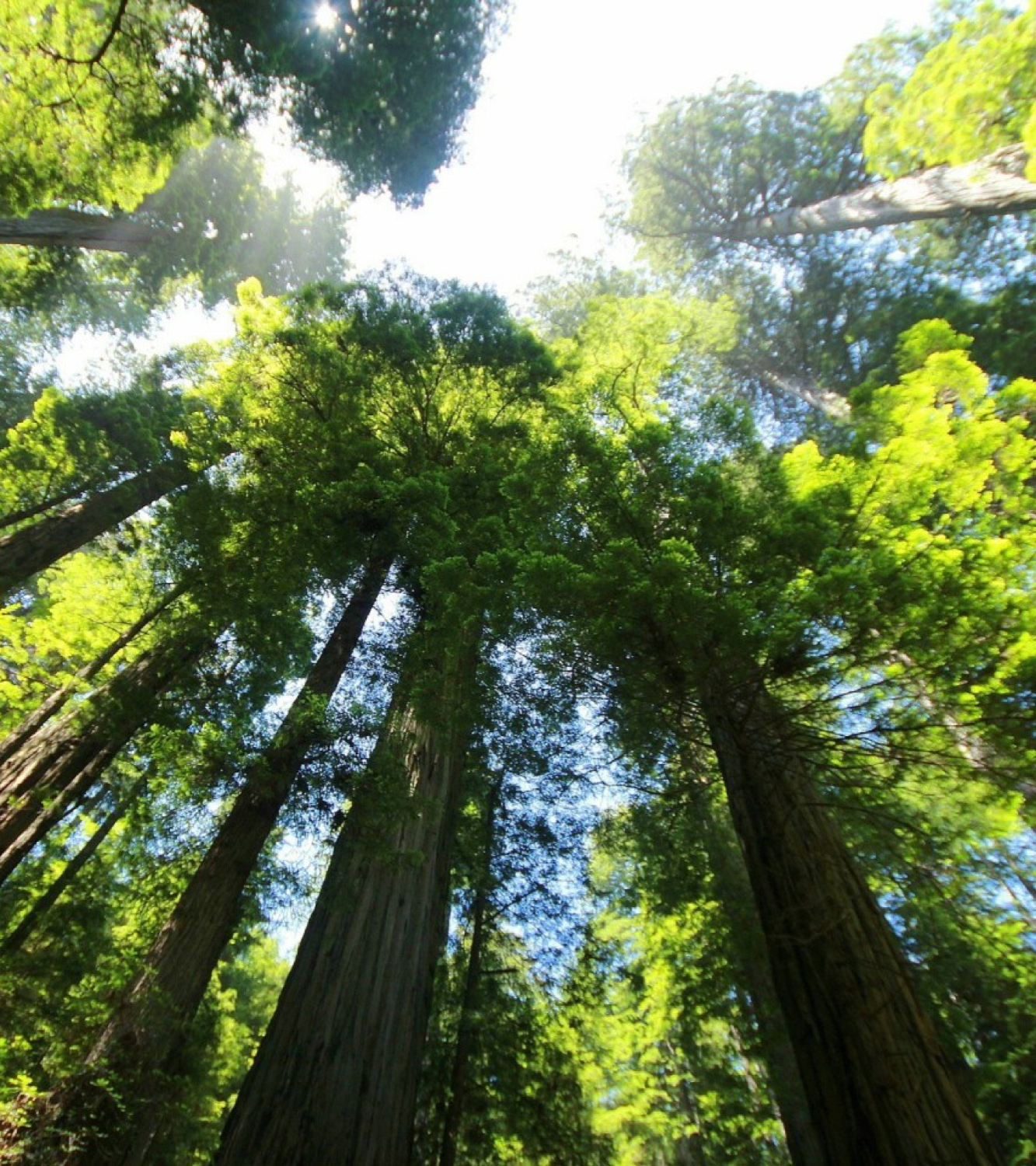
Life on Land – Living within the limits of Gravity
Life on land, on the other hand, has had to evolve strategies to overcome (or at least mitigate) gravity, with one of the greatest feats accomplished by plants – the tallest organism on land – with their ability to transport water up and through their structures against the forces of gravity – ‘upwards’ – without expending any energy (at least not directly).
The largest tree on Earth is the Sequoia of California (coastal Redwoods), which stand at around 150 metres tall, with a volume of about 1500m3. However, it is gravity (and electromagnetism) that limits the height of the tallest trees.
The electromagnetism defines the strength of the chemical bonds in the lignin (the hard, woody material that makes up much of the tree trunks and branches), and so the trees’ ability to support its’ own weight is defined by the electromagnetic forces in lignin. And plants, unlike seaweed, also need to pump water from the ground to all their leaves, and up to the very top leaf, transporting nutrients and water upwards, thanks to a combination of different physical properties of water.
One property in particular, is that when water evaporates out of the pores of the leaves (thanks to the heat from the Sun – therefore solar energy), and as the different water molecules are held together by hydrogen bonds, the rising water molecule that is released into the atmosphere, pulls the water molecule below upwards. The lower molecule does the same, to the one below it, and this pulls water up the plant like a daisy chain up the xylem tubes (the water capillary tubes). A tree of this size can raise upto 4 tonnes of water every day. However, this is also limited by electromagnetism, as the hydrogen bond daisy chain, can only pull a limited weight (which is the mass of water x gravity), before it breaks; and this is calculated to be the height of the giant Redwoods. To underline the point, as the gravitational force on Mars is a lot weaker than on Earth (about 38%) for instance, in theory, the same tree could grow taller – up to 200 meters tall on Mars, as the electromagnetic force would be the same…
There is also a hypothesis that tree snakes, that are most often in the vertical position, are effected more by the direction of the gravitational force, which has a orientational effect on the flow of blood, so that the heart has evolved closer to the brain, compared with their more horizontally oriented land and water relatives [Harvey B. Lillywhite].

Sensing Gravity
Many forms of sea-life, and land-life have also evolved the ability to sense gravity. Specific cells within many different organisms have evolved specialised structures, to sense and convert gravitational forces into biological signals. For example, otoliths in hair cells of the inner ear of many vertebrates help balance (and depth detection for fish), and statoliths in plants for sensing up and down – helping plants determine the direction of growth (upwards for stems to reach more light, and downwards for roots to reach more nutrients and water…).
